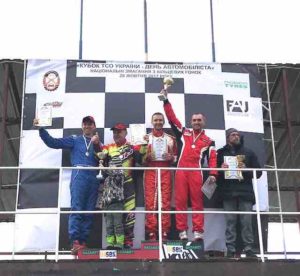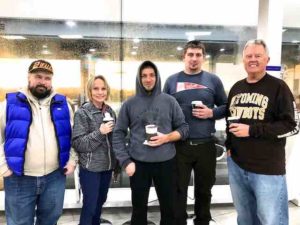
UKRAINE
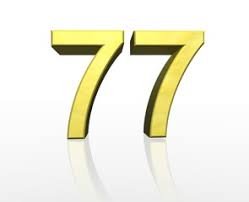
Ukraine – Trackchasing Country #77
Greetings from places on the way to Kyiv, Ukraine
Click on the links below to read about and see the photos and video from our visit to this sovereign, but often hassled by Russia, eastern European nation of Ukraine……trackchasing country #77.
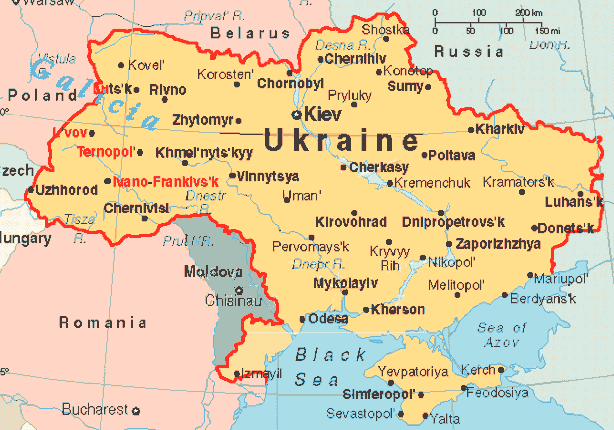
LIKE TO KNOW MORE ABOUT UKRAINE – TRACKCHASING COUNTRY #77?
As a service to my readers, I always provide a top-line background of each country I visit. If you’d like to learn a little more about the eastern European nation of Ukraine check out the “background” information I prepared for you. It appears at the bottom of this report. I have condensed this section so you can get a good “feel” for this former Russian satellite state. Ukraine has had a tough history over the years. Most of the material comes from Wikipedia. We can trust them.
PRE-TRIP
Advance Preparation
Editor’s note: We actually purchased our airline tickets to Kyiv, Ukraine, the nation’s capital, nearly four years ago. I know what you’re thinking. Airlines don’t SELL their tickets that far in advance. You are correct.
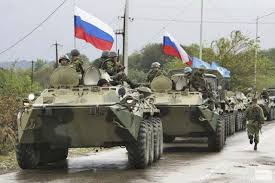
Yes, we had originally planned to trackchase in Ukraine a few years ago…..right after Russian invaded the country. With tensions running high Delta Airlines allowed a full refund of our unused tickets. At that point, Ukraine was put on the back burner.
THE RACE
I used a combination of websites, social media and Ukrainian residents, past and present to confirm the race date at the Autodrome Chayka. I could never plan and execute these trips without help from all kinds of sources.
The five-round regular racing season had been completed in September at Chayka. The last race of the year was the “Cup of Ukraine”. It was scheduled for Saturday, October 28, 2017. However, that date was not fully confirmed until about two weeks before race time. That meant I couldn’t buy our airline tickets very far in advance.
THE VISA
Foreign country travel visas can be expensive. Getting a travel visa can also be time-consuming. It’s not unusual to have to be without my passport for 7-10 days or longer while awaiting a visa O.K.
I probably have a dozen trips, and sometimes more, out of the country in a given year. Some of those trips pop up on very little notice. I can’t afford to be without my passport for 7-10 days. Luckily, Ukraine does not require a travel visa from Americans.
TIME ZONES
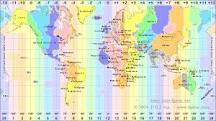
When we arrived in Kyiv their time zone was ten hours ahead of the Pacific time zone in Los Angeles. During the trip, Ukraine’s fall time change occurred. That moved the difference from ten hours to nine. With it being the fall season we “fell back” an hour giving us an extra hour of rest. When we get back to California we will “fall back” a second time when the Pacific time changes to standard time from daylight savings time next weekend.
BOOTS ON THE GROUND
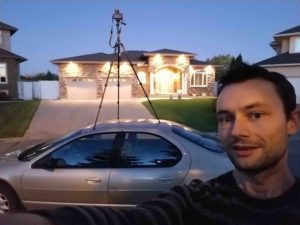
Local people with knowledge of the Ukraine racing situation made this trip a success. My first contact was Illia Sternichuk (above). I first met him at the Souris Race Park (above) up in Souris, Manitoba, Canada! Illia, now a photographer in Manitoba is originally from Ukraine. Did you know that Canada has the greatest percentage of Ukrainians living there after Ukraine and Russia?
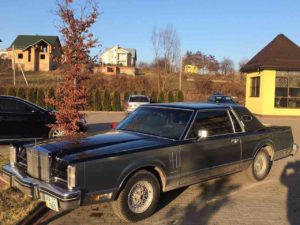
Illia put me in touch with his friend Alex Mochanov. Alex did a good job of helping out. By the way, Alex drives a Lincoln all over his home country of Ukraine. Although a self-described “old motorcycle rider”, his friend was the race organizer at Chayka.
A fellow by the name of Valery Shevelev was instrumental in the early planning stages of this trip. We started talking about this race trip as far back as last April!
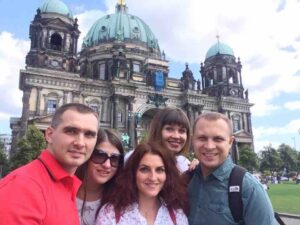
My last and most complete Ukrainian aid came from a Chayka race driver. Vadym Evtushenko – (above far left) sent me many many messages over a period of three months. His final confirmation triggered the switch for us to buy our airline tickets. Once on the ground Vadym and his friends would do even more for us.
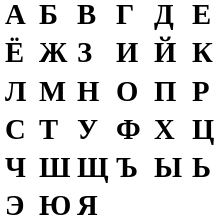
We are indebted to all of these people and many others who helped. Planning trips where the Cyrillic alphabet is used is the ultimate travel challenge. I’ve done it in several countries including Russia, Georgia and Turkey. It seems as if everywhere we travel people speak enough English to keep us from starving. However, the residents of Ukraine spoke as little English as just about any country I have visited.
THE TRANSPORTATION
Close to half of my international trackchasing trips have included business or first-class airfare. Nevertheless, I don’t think this type of travel is really a good value. Rather than pay $4,000 U.S. for a business class airline trip I would rather pay $800 U.S. for a seat in coach. I don’t have a problem flying coach. I would much rather land in a foreign place with $3,200 U.S. bulging out of my back pocket. For the many times that I have flown “upfront” I have my airline sponsors to thank. For the past few years, we have paid for all of our international travel.
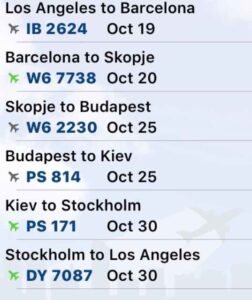
This trip would have us flying for more than 32 hours. This is what the flight travel itinerary looked like.
Los Angeles, California – Barcelona, Spain – 11H45M
Barcelona, Spain – Skopje, Macedonia – 2H45M
Skopje, Macedonia – Budapest, Hungary – 1H30M
Budapest, Hungary – Kiev, Ukraine – 1H40M
Kiev, Ukraine – Stockholm, Sweden – 2H30M
Stockholm, Sweden – Los Angeles, CA – 11H0M
We would be gone from home for twelve days. Fortunately, we were only flying on three of those days. The above flight schedule covers more than 14,000 miles. That might seem like a lot until you consider that my total travel mileage (rental car and airlines) is a bit over 200,000 miles already for 2017.
CURRENCY
Carol is my international currency dealer. I don’t know how she does it. I simply tell her where I’m going and a pile of local currency shows up on my desktop a day or two later. What would I do without her?
This trip was minorly different. Our local bank doesn’t provide currency for Macedonia or Ukraine. However, we were loaded down with euros. We had so many euros we had to offload some of them just to make sure our luggage didn’t weigh too much! O.K., I’m kidding. You all know I’ve never had the financial resources of my fellow competitors, the Dreaded East Coast Trackchasers.
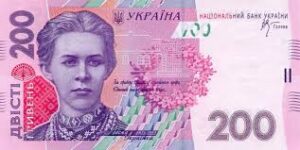
In Kyiv, it was super easy to exchange euros for Ukrainian Hryvnia. There are all kinds of moneychangers in the city centre offering fair exchange rates. Right now one U.S. dollar will buy you $26.87 hryvnia. One U.S. dollar will get you $0.86 euros. The dollar has been generally strong. We found prices for just about everything in Ukraine to be very inexpensive. If you’re looking for an interesting country to visit that won’t deplete your piggy bank I can highly recommend Ukraine.
WEATHER
It’s the fall season in Eastern Europe. About ten days ago the Kyiv city high temperatures were in the 65-70 degrees Fahrenheit range. Sadly, those temps didn’t hold.
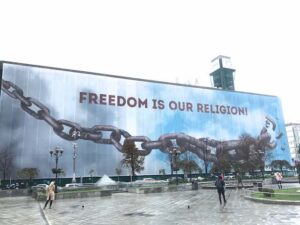
Nevertheless, the high temperature each day was 47-54, which wasn’t bad at all. At first, we were disappointed when we saw the temperatures falling from 65 to 70. Then we were pleased the high temperature didn’t decline to 37 degrees, again Fahrenheit, which was the forecast a few days before we arrived. It did rain from time to time but it always seemed to hold off when we needed it too. Yes, life like golf is all about your expectations.
OVERNIGHT ACCOMMODATIONS
I have now trackchased in 77 countries. Carol’s total is forty-two. We have visited several more countries. We’ve probably been to Europe well over fifty times. Yes, we’ve done our share of traveling.
I don’t think anyone really travels as we do. We rarely ever use a tour group. We’ve done that twice, first in China and during our first trip to Russia. Both of those trips were guided tours. We enjoyed them very much and kept in touch with people we met on those trips for years. We even stayed in the U.S. homes of people we met in China. However, group travel is not really our “deal”. We like the adventure of traveling on our own schedule.
We are not budget travelers. Hostels are not our “deal” either. Having traveled so much, I know how to buy travel right. We stay in first-class accommodations most of the time at prices most people would be paying for budget hotels.
Let me give you an example. On this trip, we first stayed for five nights in a “ship” style hotel in Skopje, Macedonia. This was a trip highlight. Do not miss the pictures of this most unique hotel.
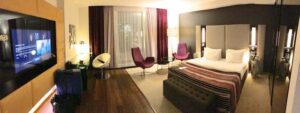
Then we stayed for five nights in the 11 Mirrors Hotel in Kyiv, Ukraine. This was a boutique hotel. There were only five rooms on each floor. Both of these hotels were located in the city centre. Both included a full breakfast served in luxurious surroundings.
I told you I know how to buy travel right. You can be the judge of whether or not that is true. We stayed ten nights in four and five-star hotels located in the city center of the European capitals of Macedonia and Ukraine. What did we pay for ten nights of this type of accommodation? How does $367 U.S. sound? It sounded pretty good to me. Carol was comfortable too!
THE RENTAL CAR
We didn’t have a rental car in any of our travel plans for this trip. We had local friends giving us rides. In Ukraine, we used Uber as well. They are a great source for getting from point A to point B. You don’t have to worry about having the right currency. The fare is charged electronically to my credit card. There’s no language barrier either. The pickup and drop-off points all emanate from my phone.
It wasn’t until the last day of our trip that a rental car entered our plans. We would need that car for a 400-mile round-trip. This trip didn’t materialize until the next to last day of our 12-day adventure. I’ll tell you all about that as we go along.
NAVIGATION
I wasn’t driving. I didn’t need any navigation help. However, my Uber drivers and the folks who drove our rental car used their phones for GSP help constantly. With the Cyrillic alphabet and no GPS aid, I think it would be nearly impossible for an American tourist to drive himself or herself around.

THE TRAVELING COMPANION
Cinderella got to go on this trip! Believe it or not, Carol actually loves scrubbing floors and doing laundry at home. She’s “old school”.
As you may know, I don’t value “old school” from just about anyone on any subject. Tech lets you work smart and not always hard. I’ll take smart over hard any day. However, the old school people are not going to change their ways. That’s why they are old school. No problem. As my used car salesman friend used to say, “There’s an ass for every seat”.
It was nice to have Carol along on this trip. We would see so much. We would do so much. I was most happy that our accommodations were so luxurious. Carol deserved the comfort.
Carol is in shape. Her nickname is “Trackchasing’s First Mother”. She’s the first and the only female trackchaser in the top 50 or so to have had children. She is easily in the best shape of any female trackchaser. I don’t think it would be a stretch to say she’s in the best shape of any trackchaser, male or female as well! Good on her.
On this trip, we routinely walked more than four miles every day. On one day’s trip out of the city, we walked 5.8 miles (9.3 kilometers) and climbed 18 flights of stairs. Carol never missed a beat.
She helps make sure I don’t overlook anything on these trips. I tend to take a 30,000-foot view of things. Carol works at ground level. We complement each other. It’s always good to have her on the trip. Ukraine would be her 42nd trackchasing country. No other female chaser comes anywhere close to that total.

THE SUMMARY
My “world map” has filled up surprisingly quickly. However, there are “agents” working as you read this on new trackchasing countries to visit. I appreciate every one of their contributions.
RLR – Randy Lewis Racing Lifetime Trackchasing Countries
# 1 – UNITED STATES OF AMERICA – Peoria Speedway – Mt. Hawley (oval) – Track #1, Peoria, Illinois – circa 1955
# 2 – CANADA – Cayuga Speedway (oval) – Track #174, Nelles Corner, Ontario – 1988
# 3 – AUSTRALIA – Parramatta City Raceway (oval) – Track #180, Granville, New South Wales – 1989
# 4 – UNITED KINGDOM – Northhampton International Raceway (oval) – Track #378, Northhampton – 1999
# 5 – NETHERLANDS – Driesum Racetrack (oval) – Track #839, Driesum – 2005
# 6 – BELGIUM – Bellekouter oval (oval) – Track #841, Affligem – 2005
# 7 – FRANCE – Circuit de Croix en Ternois (road course) – Track #843, Saint-Pol sur-Ternoise – 2005
# 8 – GERMANY – Nurburgring (road course) – Track #844, Nurburg – 2005
# 9 – NEW ZEALAND – Western Springs Speedway (oval) – Track #1,134, Western Springs – 2006
# 10 – MEXICO – Triovalo Bernardo Obregon (oval) – Track #1,281, Tiajamulco de Zuniga, Jalisco – 2007
# 11 – BARBADOS – Bushy Park Racing Circuit (road course) – Track #1,296, Bushy Park – 2007
# 12 – THAILAND – Bira Circuit (road course) – Track #1,300, Pattaya – 2008
# 13 – SOUTH AFRICA – Durban Grand Prix (road course) – Track #1,315, Durban, KwaZulu-Natal – 2008
# 14 – JAMAICA – Dover Raceway (road course) – Track #1,322, Brown’s Town St. Ann – 2008
# 15 – SWEDEN – Sturup Raceway (road course) – Track #1,335, Malmo – 2008
# 16 – DENMARK – Ring Djursland (road course) – Track #1,336, Tirstrup – 2008
# 17 – CZECH REPUBLIC – Automotodrome BRNO (road course) – Track #1,381, Brno – 2008
# 18 – AUSTRIA – Lambrechten Stock Car Track (road course) – Track #1,382, Lambrechten – 2008
# 19 – IRELAND – Tipperary International Raceway (oval) – Track #1,388, Rosegreen – 2008
# 20 – GUYANA – South Dakota Circuit (road course) – Track #1,390, Timehri – 2008
# 21 – CHINA – The Guia Circuit (road course) – Track #1,392, Macau – 2008
# 22 – COSTA RICA – Autodromo La Guacima (road course) – Track #1,398, La Guacima – 2008
# 23 – ANDORRA – Grandvalira Circuit (road course) – Track #1,404, Port d’Envalira – 2009
# 24 – ARGENTINA – Circuito Efren Chemolli (oval) – Track #1,406, Buenos Aires – 2009
# 25 – QATAR – Losail International Circuit (road course) – Track #1,408, Doha – 2009
# 26 – BAHRAIN – Bahrain International Circuit (road course) – Track #1,410, Sakhir – 2009
# 27 – UNITED ARAB EMIRATES – Dubai Autodrome (road course) – Track #1,411, Dubai – 2009
# 28 – COLOMBIA – Autodromo de Tocancipa (road course) – Track #1,415, Tocancipa – 2009
# 29 – SPAIN – Motorland Aragon (road course) – Track #1,416, Alcaniz – 2009
# 30 – PORTUGAL – Circuto de Murca (road course) – Track #1,417, Murca – 2009
# 31 – ICELAND – Kapelluhraum (road course) – Track #1,420, Hafnafjorour – 2009
# 32 – HUNGARY – Hungaroring (road course) – Track #1,426, Mogyorod – 2009
# 33 – SWITZERLAND – Hock Ybrig (road course) – Track #1,427, Hoch Ybrig – 2009
# 34 – ITALY – Vighizzolo d’Este Stock Car Track (road course) – Track #1,428, Vighizzolo d’Este – 2009
# 35 – DOMINICAN REPUBLIC – Autodromo Mobil 1 (road course) – Track #1,515, Santo Domingo – 2009
# 36 – MALTA – Ta’Qali Race Track (road course) – Track #1,521, Ta’Qali – 2010
# 37 – FINLAND – Lake Pidisjarvi Ice Track (road course) – Track #1,524, Nivala – 2010
# 38 – JAPAN – Suzuka Circuit (road course) – Track #1,530, Suzuka – 2010
# 39 – CHILE – Autodromo de Interlomas (road course) – Track #1,531, Temuco – 2010
# 40 – MOROCCO – Circuit de Marrakesh (road course) – Track #1,535, Marrakesh – 2010
# 41 – BRAZIL – Circuit de Caruaru – Aryten Senna (road course) – Track #1,540, Caruaru – 2010
# 42 – ESTONIA – Laitse Rally Park (road course) – Track #1,571, Laitse – 2010
# 43 – LATVIA – Bikernieki (road course) – Track #1,572, Riga – 2010
# 44 – GUATEMALA – Autodromo Pedro Cofino (road course) – Track #1,580, Alotenango – 2010
# 45 – EL SALVADOR – El Jabali (road course) – Track #1,582, Quezaltepeque – 2010
# 46 – ROMANIA – Bradu (road course) – Track #1,603, Bradu – 2010
# 47 – BULGARIA – Closed Route – Burgas (road course) – Track #1,604, Burgas – 2010
# 48 – SOUTH KOREA – Korea International Circuit (road course) – Track #1,605, Yeongam, Jeollanam-Do – 2010
# 49 – PHILIPPINES – Batangas Racing Circuit (road course) – Track #1,608, Batangas – 2010
# 50 – NORWAY – Lyngas Motorbane (road course) – Track #1,648, Lier – 2011
# 51 – MALAYSIA – Sepang International Circuit (road course) – Track #1,656, Sepang – 2011
# 52 – INDONESIA – Sentul International Circuit (road course) – Track #1,657, Babakan Madang, Boder – 2011
# 53 – LUXEMBOURG – Alzingen (road course) – Track #1,711, Alzingen – 2011
# 54 – POLAND – Tor Slomczyn (road course) – Track #1,713, Slomczyn – 2011
# 55 – SINGAPORE – Marina Bay (road course) – Track #1,714, Singapore – 2011
# 56 – URUGUAY – Piriapolis Grand Prix (road course) – Track #1,724, Piriapolis – 2011
# 57 – SRI LANKA – Pannala Race Track (road course) – Track #1,732, Pannala – 2012
# 58 – ECUADOR – Autodromo Internacional de Yahuarcocha (road course) – Track #1,736, Ibarra – 2012
# 59 – SLOVAKIA – Slovakia Ring (road course) – Track #1,745, Orechova Poten – 2012
# 60 – MONACO – Circuit de Monaco (road course) – Track #1,747, Monte Carlo – 2012
# 61 – CROATIA – Automotodrom Drobnik (road course) – Track #1,762, Rijeka – 2012
# 62 – PERU – Autodromo La Chutana (road course) – Track #1,802, Lima – 2012
# 63 – GREECE – Serres Circuit (road course) – Track #1,807, Serres – 2012
# 64 –RUSSIA – Moscow Central Hippodrome (oval) – Track #1,824, Moscow – 2013
# 65 –LITHUANIA – Marijampole Autocross Track (road course) – Track #1,842, Marijampole – 2013
# 66 –INDIA – Buddh International Circuit (road course) – Track #1,915, Noida – 2013
# 67 –GEORGIA – Rustavi International Motorpark (road course) – Track #1,916, Rustavi – 2013
# 68 –TRINIDAD AND TOBAGO – Larry Gomes Stadium (road course) – Track #1,928, Arima – 2014
# 69 – TURKEY – Istanbul Park (road course) – Track #2,035 Akfirat – 2014
# 70 – AZERBAIJAN – Streets of Baku (road course) – Track #2,037, Baku – 2014
# 71 – SERBIA – Usce (road course) – Track #2,224, Belgrade – 2016
# 72 – BOSNIA AND HERZEGOVNIA – Zaluzani (road course) – Track #2,235, Banja Luka – 2016
# 73 – PANAMA – Circuito Internacional de Panama (road course) – Track #2,290, La Chorrera – 2016
# 74 – ZIMBABWE – Bulawayo Motorsports Park (road course) – Track #2,291, Bulawayo – 2016
# 75 – NAMIBIA – Desert Raceway (oval) – Track #2,369, Walvis Bay – 2017
# 76 – MACEDONIA – Skopje Street Circuit (road course) – Track #2,386, Skopje – 2017
# 77 – UKRAINE – Autodrome Chayka (road course) – Track #2,387, Kiev – 2017
One might think I am running out of countries for that next trackchasing trip. It is getting harder….but I’m not done yet! Plans are currently in the works for trackchasing country #78 and beyond.
So how did this trip really come down?
Wednesday – October 25, 2017
Today was a relocation day. We had just stayed for five nights in the country of Macedonia. We had a great time there. Now it was time to go from Macedonia to Ukraine.
The staff at the Randy Lewis Racing research department had burned the midnight oil on many occasions to make this trip just perfect for Trackchasing’s First Mother. She seemed to be having a good time. Good job RLR research department!
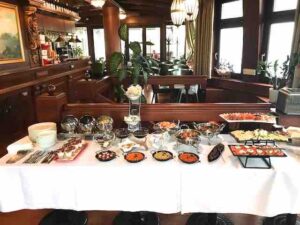
We began the day with our breakfast at the Hotel Senigallia in the city centre of Skopje, Macedonia. This has been a great place to stay. Their morning breakfast was a solid trip highlight.
It would require a little soft negotiating to get our taxi driver to take us to the airport for €20. That’s the going rate. I would not have hopped in a cab without an agreement on the price, to begin with.
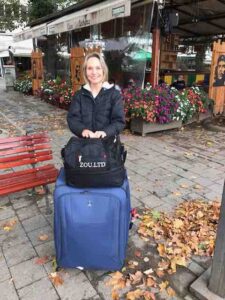
It was a good 20-30 minute drive out to the airport. We were plenty early. We were checking one very large bag that weighed in the neighborhood of 55 pounds (about 25 kilograms).
Carol and I each had a carry-on bag. Carol’s current carry-on bag was purchased in a Skopje luggage shop after her original back fell apart on the first part of this trip. The luggage salesperson was quick to point out that the luggage she was buying met all budget airlines’ requirements for carry-on baggage.
We had some angst back at home wondering whether or not our checked bag would weigh too much or if our hand-carried luggage would be too large. We were flying on several different airlines including Iberia, Wizz Air, Ukraine International and Norwegian Airlines. That’s a pretty eclectic group of air carriers.
It turned out that no one had any major heartburn over the weight of our big bag (so far). Additionally, our handbag carry-ons had been acceptable. We had incurred no additional or extra baggage charges. I grew up in an era where there were no baggage charges. I try to avoid them at great lengths.

Because we were so early in Macedonia I could power walk outside the Skopje airport for more than 30 minutes. With a temperature in the low 50s, it was great for a little bit of exercise. I collected about 2 1/2 miles during that walk. By the end of the day, my iPhone pedometer showed 4.1 miles exceeding my daily mileage goal by just enough.
Our flight from Skopje to Budapest, Hungary took only an hour and a half or so with Wizz Air. Once in Budapest, we had to clear border control. We also had to retrieve our checked bag and then recheck it with the airline taking us from Budapest over to Kyiv, Ukraine.
Discount airlines like Wizz Air do not have baggage check agreements with other airlines. That means when you’re flying in with Wizz Air and make a connection you have to get your bag at baggage claim and then recheck it with whatever airline you’ll be continuing the trip on. We’re going to have to do that three times on this trip because we’re using six airlines. So far this hasn’t been a real issue.
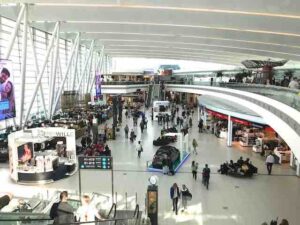
In Budapest, we grabbed a quick Chinese lunch. They have a beautiful terminal with an outstanding food court. We didn’t have a lot of time but we had enough time. However, there is always a “however” in life, following lunch we discovered we had to clear Hungary’s border control one more time to get OUT of the country. Heck, we had only been IN Hungary for an hour or two! We hadn’t exactly been anticipating this. It took longer than expected. Fortunately for us, our flight was delayed by about 15 minutes or we would have come very close to missing the plane.
The flight from Budapest to Kyiv was scheduled for two hours and 40 minutes. Ukraine International Airlines, another discount airline, charges for things like soft drinks and the like.
We landed at about 6:30 p.m. It was dark by now. When we got off the airplane we had to ride a bus back to the terminal. Lots of European airports use this bus system to get passengers from the plane where it has landed back to the terminal. This allows the airport to accept many more flights than they have gates for. You won’t see at virtually any airports in the United States.
The lines were long to clear Ukrainian border control. It probably took us 10-15 minutes. In today’s world that’s longer than average.
I try to develop solid and reliable local contacts to give us the best chance for a successful trip. I’ve done that in most of the countries we have visited. This has allowed me to develop many international friendships.
My primary contact in Ukraine was a young man named Vadym Evtushenko. His name in Ukrainian was Вадим Евтушенко. However, I don’t know how to read the Cyrillic alphabet so I was allowed to call him Vadym! He and I had corresponded several times a week over the past couple of months. Vadym was a racer. He was willing to give me as much information as I asked for….and I asked for a lot.
It’s important to remember that until I arrive in a country I have never actually met any of these people who help and advise me. I’m at their mercy regarding the accuracy of their information. How much am I at their mercy? Based upon the information people like Vadym gave me I invest thousands of dollars that I can’t get back if what they are telling me is wrong. Yes, I am a trusting individual.
Vadym had volunteered to drive out to the airport and pick us up. I didn’t want to impose but Vadym insisted. He would take us to our hotel in city centre of Kyiv. This was a very generous offer by the Vadym. We really appreciated his help.
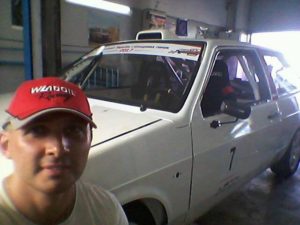
I had asked Vadym how I would recognize him. He sent me back a picture of him wearing a red baseball hat. I would look for the man in the red hat. They don’t wear baseball hats a lot in Europe so his photo was going to be very helpful.
When we finally made it to the exit at the Boryspil International Airport there was Vadym wearing his red baseball hat just like he had promised. I love it when a plan comes together! We introduced ourselves. After so many messages over several months, it was great to meet him.
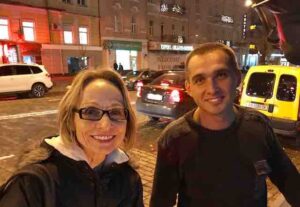
We talked about all sorts of things on the 30-minute drive into the city centre of Kyiv. We’ll be rooting for Vadym when he drives the #7 with his brother Andrew in Saturday’s races at the Autodrome Chayka on Saturday.
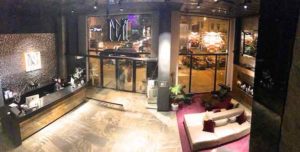
Carol and I will be staying at the 11 Mirrors Hotel (hotel lobby above) in Kyiv. It’s a very upscale boutique hotel. I have “status” with the Starwood Preferred Guest program. That status gave us an upgraded deluxe room. You won’t want to miss the photos of the space we’ll be staying in for the next five nights.
Our room was very modern and included a huge flat-screen TV. I’ve never seen a bigger one in a hotel room. The bathroom had two toilets. O.K., I know they weren’t really TWO “toilets” but this simply proves we were staying in an upscale place.
Again because of my status with Starwood breakfast will be included with our room each morning. That will be nice. They serve until 11 a.m. so we don’t have to rush out of bed early in the morning to have breakfast.
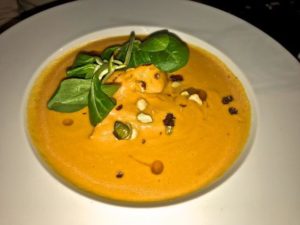
Tonight we had a late dinner at about 8 p.m. in the hotel’s second-floor restaurant. The service was a bit slow but the food was quite tasty (pumpkin soup with prawns) and reasonably priced especially for an upscale hotel. We would come to find out that just about everything in Ukraine is super low priced for Americans.
Touring and seeing the sights is a major part of my trackchasing hobby. This is especially true when we make foreign country visits. On every day except race day, we have some very unusual tourist attractions to fill our schedule. When I’m done explaining them I think you’ll agree with me that these are some of the very best touring opportunities that one could expect in any foreign country they might visit.

Ukraine is a long way from the United States in so many ways. We’re glad to be here. We are looking forward to my getting trackchasing country #77 in a couple of days.
Thursday – October 26, 2017
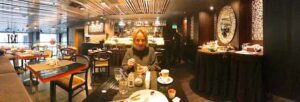
Today was scheduled for a full day of touring. We started with breakfast at our 11 Mirrors Hotel. Because of my status with the Starwood Preferred Guest program, these deluxe breakfasts are complimentary for Carol and me.
The presentation of the breakfast was outstanding. I wasn’t a huge fan of the food except for the bread, butter and jelly. Carol likes everything and really enjoyed what the hotel served. I’ve always been a big breadman. Our breakfast ambiance was as good as what we had at our “ship” hotel in Macedonia last week.
The first item on the agenda was going to be an 8 a.m. walking tour. It was scheduled to last for about three hours. There was no charge for the tour. The guides depended 100% on tips. I like that idea. That meant the guides would be paid based on their performance. We were very much looking forward to it. Unfortunately, we couldn’t find the tour location at Independence Square in downtown Kyiv. We ended up missing the tour!

That’s when Randy Lewis Racing stepped in and created a special customized tour for Carol. We saw a lot even though we didn’t always know what we were seeing on the RLR tour!
The weather came in at about 50°. It rained lightly for a few short minutes. The wind flew through at about 10 MPH. I would not have wanted it to be any colder. I did pick up a beautiful blue and yellow Ukrainian scarf as well as a very warm snug-fitting pair of gloves. They were five bucks each. Prices in these Eastern European countries are fantastic.
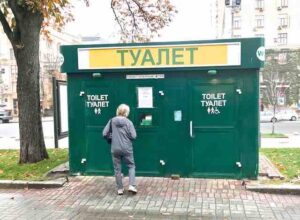
There were a few public toilets on the streets of Kyiv. Many European countries have a nasty habit of charging to use public toilets. Oh, my! Today Carol used one and spent about 15 cents U.S. for the privilege. She was not impressed with the experience.
We always have a good time on formal tours. However, most of the time we have an even better level of enjoyment just bouncing around and seeing what we can see.

At around noon we stumbled across an underground shopping mall. We spent some time rummaging through a grocery store and then hit the food court. I found a place serving khinkali like I enjoyed so much during my visit to nearby Georgia.
In several instances, we had to walk underground to cross major streets. You won’t see that in the U.S. The underground is often filled with shops like you might find in Grand Central Station in New York City. There are always lots of interesting things to see in these small retailers.
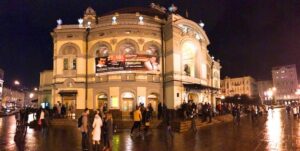
The real highlight of the day was going to be seeing a performance of Sleeping Beauty performed as a ballet at the Ukrainian National Opera House. The theatre was only 300 meters from our hotel. It was a perfect location.
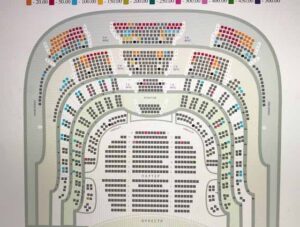
I had ordered our tickets a couple of weeks ago. I did all of the ticket ordering on a Ukraine website. Everything on the site was written in the Cyrillic alphabet. I just kept using my intuition to pick the tabs and links I would need until they accepted my credit card! We had outstanding seats at very little cost.
The ballet was scheduled to begin at 7 p.m. I figured (wrongly) the performance might be finished by 9 p.m. or so. I told Vadym we would meet him afterward for a late-night (to us) dinner.
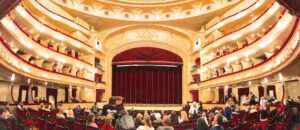
The theater was very ornate. It was established all the way back in the summer of 1867. As you might imagine the Opera house initially featured Russian operas. In 1896 the building caught fire and burned to the ground. It was rebuilt and reopened in 1901. In 1911 Ukraine’s prime minister, Pyotr Stolypin was assassinated there. Yes, the Ukrainian National Opera House has had an exciting history prior to members of Randy Lewis Racing coming to visit.
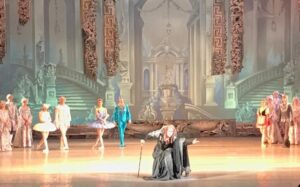
The performance began at 7 p.m. With two intermissions it didn’t finish until about 10:15 p.m. I had to call Vadym after the first pause to tell him we would have to cancel our dinner plans for the evening.
I didn’t want to do that. I hate backing out on commitments. However, I had a commitment to Carol as well. Vadym was very understanding of the situation.
We’ve seen these kinds of ballet productions all over the world now including the Sydney Opera House in Australia and the Bolshoi Theater in Moscow Russia. It’s a great cultural experience.
It was now beginning to push 11 p.m. Europeans eat their last meal of the day very late. We normally have supper in San Clemente at about 5:30 p.m.!
There was a restaurant located directly across the street from the hotel called Mafia. We stopped in there for dinner. This was a fine dining sit-down restaurant.
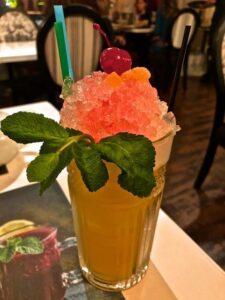
We ended up having five drinks, (two alcoholic) and two main entrées. I went with the spaghetti carbonara. For dessert, we dined on cherry cake with vanilla ice cream. This meal would cost $60-80 or more in a U.S. restaurant. Tonight‘s bill came in at 603 Ukrainian hryvnias or about $22 U.S.
Even though we stayed in top-notch hotels, ate like kings and have been transported all around these capital cities the costs have been beyond reasonable…. on the low side. If you’re planning a vacation I recommend Macedonia and Ukraine. There will be lots to do including great restaurants and you won’t spend very much money. The airfares are comparable to what it might be cost you to fly to Hawaii.
We’ve got a big day planned tomorrow including a very highly recommended Trackchasing Tourist Attraction. If it lives up to its billing it’s going to be one of the very best things we’ve ever done.
By the way, if you get the chance you might want to check out my Trackchasing Tourist Attraction page. It’s located on my website at www.randylewis.org. It will give you a sampling of the places I have visited on the way to all of these racetracks. Here’s the link:
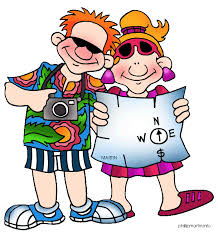
Trackchasing Tourist Attractions
Friday – October 27, 2017
Today was going to be one of the most intensive and unique Trackchasing Tourist Attractions we had ever encountered. We learned about the opportunity while doing a city centre tour in Skopje, Macedonia a few days ago.
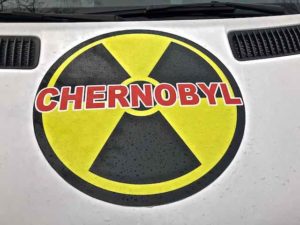
We had struck up a conversation with a young man from Minneapolis. He tuned us into the Chernobyl Nuclear Disaster site tour. When I checked out his recommendation with TripAdvisor users and the plan was a go. More than one reviewer told us the Chernobyl tour was the best thing they had ever done. I like to take other people’s ideas and run with them.
I went online to make reservations. To some, the tour might have seemed pricey. Actually, we were getting a tour that began at 8 a.m. and didn’t have us returning to Kyiv until past 8 p.m. We paid the $79 U.S. per person tour fee and an additional $10 p/p for insurance. We declined the offer to have our own personal Geiger counter for $10 each! I’ll tell you more about that later.
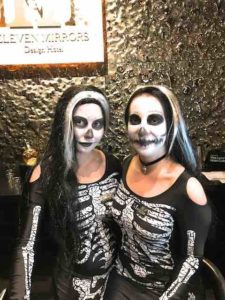
We woke up to breakfast at the 11 Mirrors Hotel in the city centre of Kyiv. The hotel has a young staff. They were really excited about Halloween happening in a few days. I’m not sure why they were in their costumes four days before the holiday but they were. Halloween music wafted through the hotel lobby and restaurant. They had some sort of Halloween treat displayed as part of the breakfast buffet. It truly looked as if they had cut off the fingers of dissatisfied guests or maybe controlling Russians.
After breakfast, we took a 15-minute walk to Independence Square. We would pick up the Chernobyl tour there. Carol and I were designated bus #1 of the three buses waiting to pick up tour guests. Our bus seated 18 passengers plus the driver and tour guide. We were one short of capacity giving me two seats for the price of one.

Our guide, Vika, was a young Ukrainian woman. I’ve going to guess she might have been about thirty years of age. She spoke English with a cute Ukrainian accent. She had a fantastic sense of humor. She had a passion and enthusiasm for informing and entertaining her guests for what would be a 12-hour tour. Well done Vika!
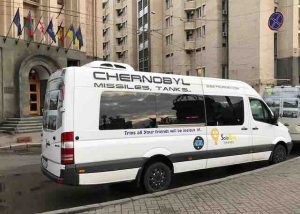
It was going to be a two-hour drive from the city centre of Kyiv to Chernobyl. We would make the trip on an 18-passenger bus. During the drive, they showed a more than one-hour documentary of the Chernobyl nuclear disaster that occurred on April 26, 1986. This was a good way to get us “caught up” on what had taken place more than thirty years ago.
About midway on the drive up to Chernobyl, we stopped at a gas station convenience store. We would stop at a few convenience stores during our time in Ukraine. Every one of them was as modern as anything I’ve seen in the states.
Little did we know that this was the last time we would see a fully normal restroom. In Europe, restrooms are called “toilets”. Toilet doesn’t sound as romantic as restroom does it?
We took the opportunity to buy a few snacks. Lunch would be provided on the tour but you never know when you’re going to get a case of the munchies.
We ordered a hot dog as well. We have always noticed that foreign countries do most things just a bit differently than we do. I guess that’s why they are “foreign” countries!
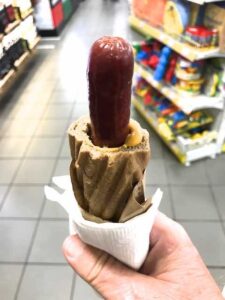
Let me try to describe the hot dog bun to you. Imagine a cylinder-looking piece of bread. The cylinder is about 10 inches long and maybe 2-3” around. The center of the cylinder is hollowed out. Ketchup and mustard are then squirted down into the cylinder’s center cavity. Then the hot dog is inserted into the bread cylinder. On the way in it gets “ketchupped and mustarded”. Genius!
In advance of the tour, it was explained that we would be exposed to a small amount of radiation but not that much. Carol and I are adventure travelers. You’ve probably noticed that.
What’s a little radiation, right? We were told that flying on an airplane (closer to the sun?) would give you more radiation than touring Chernobyl!
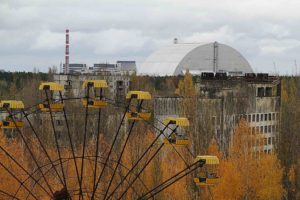
Radiation can cause a problem based upon two things. The first, is how much radiation is present. Secondly, is how long you are exposed to radiation. The Q&A section of the Solo East Tours website explained that we wouldn’t be in the radiated area long enough to suffer any harm. They also told us that the area had been cleaned up and now radiation levels were “acceptable”. If you can’t believe a website’s “Q&A” when it comes to nuclear radiation then what can you believe?
I can tell you right now that this tour would never pass muster in the United States. That has nothing to do with radiation levels. It does have something to do with other safety issues.
The drive up and back to Chernobyl took four hours. For the other eight hours, we were on the bus and walking the grounds. We must have gotten on and off the bus more than forty times.

When we were off the bus we did a lot of walking and climbing. My iPhone pedometer at the end of the tour showed we climbed 18 floors of stairs. We did nine of those floors in one residential building.
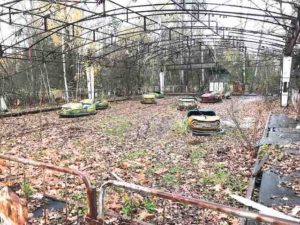
Over the years vandals have struck the areas surrounding the Chernobyl nuclear reactor site. That meant that all kinds of broken glass, wires, pipes and such were everywhere. As the tour group walked here and there the sound of crunching glass was constant. At my height, all kinds of low ceilings and metal hazards tried to prove to me that I really did need the tour group’s insurance. No, this tour would never be allowed in the U.S.
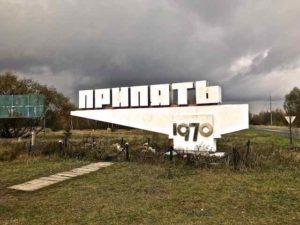
I would save the #1 highlight of the tour was exploring the ghost town of Pripyat. Pripyat was a city of about 50,000 people. It was supposed to be a model city. Most of the heads of households that lived there worked at the Chernobyl nuclear power plant. The plant was only 1-2 miles from Pripyat.
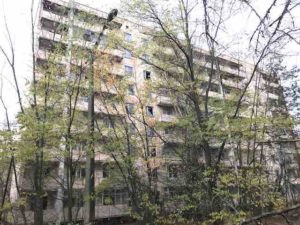
When the accident happened residents of Pripyat were told, about 36 hours after the explosion, they would have to evacuate. They were also told they would be allowed to return to their homes in 2-3 days. That promise proved to be inaccurate by a long shot. Now more than 100 large residential buildings are totally vacant and have been for more than thirty years.
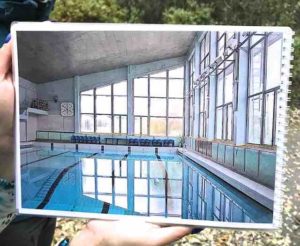
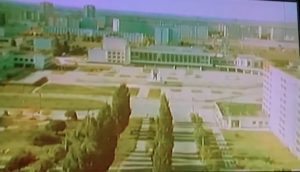
Pripyat was designed to show the world that a brand new city with lots of upgraded amenities could co-exist with a nuclear plant right new door. There were more than 100 Soviet-style residential buildings in the city. These “apartment” type buildings were around 10 stories tall. They were large enough that 50,000 residents could live in about 100 of them. There were indoor Olympic-sized swimming pools, modern (for the time) grocery stores, an arcade with bumper cars and a Ferris wheel. A huge sports stadium adorned Pripyat.
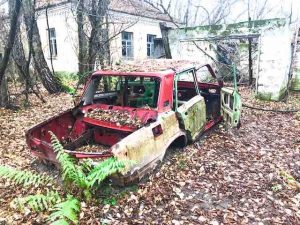
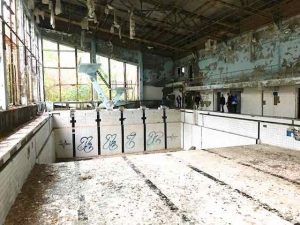
Today Pripyat is a full-fledged ghost town. Imagine a town of 50,000 people in 1986 all leaving town, never to return, in such a short time. Time and vandals have taken their toll on the situation. Please do not miss my photos of Pripyat. If you ever get to Ukraine you won’t want to miss the Chernobyl nuclear disaster tour. By the way, compare the “before and after” photos of the Pripyat Olympic sized pool from above!
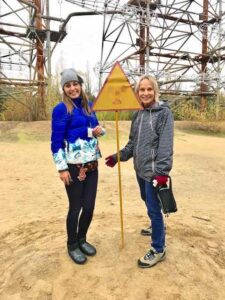
I’m really glad we did this tour. Now I can charge my cellphone by simply holding it in my hand! Kidding…..I think.
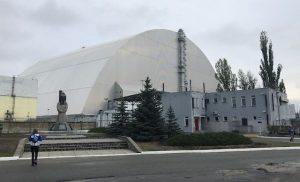
We were pretty tired puppies when we got back to Independence Square in Kyiv. We had walked 5.8 miles (that’s 9.2 kilometers) and climbed 18 floors of stairs. But then how many people get the chance to get this close to the biggest nuclear disaster of its kind?

We were happy to have passed two exit tests. On the way out of Chernobyl, the bus stopped twice. While a security guard cleared our bus with his Geiger counter the tour members were herded into a building. There we placed our hands on a machine that measured our current level of radioactivity. Today everyone passed.
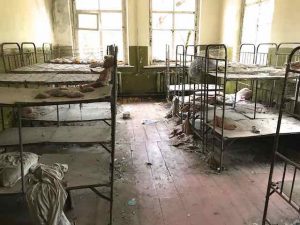
Much of our tour was done in light rain. Quite a bit of the walking was done in the forest. The toilet facilities were beyond “rustic”, especially the “Russian toilets”. Most Ukrainians don’t seem all that fond of Russia. Maybe that’s why they labeled the worst of the worst “squat” toilets “Russian” toilets. You certainly get the feeling that everyone left on short notice and never returned like the picture of a kindergarten school shows above.
Following the tour, we walked 15 minutes back to the area where our hotel was located. Yep. I’m pretty proud of Carol. I think far less than 10% of Americans 50 years of age or older could have kept up with us on today’s tour.
For the second night in a row, we had dinner at the “Mafia” restaurant that was located pretty much across the street from our hotel. Even though we really enjoyed this place last night I don’t like to eat in the same place twice when I’m touring. Why? Let me explain.
We love eating out in upscale restaurants on these trips. Sometimes they are expensive and sometimes not. Normally, we have a recommendation from someone or some source for each dinner location we frequent.

That’s why we are rarely disappointed in our choices. Last night the food and drink at the Mafia restaurant were well above average. However, it was only one data point. If we chose somewhere else to eat this evening we might do just as well or even better. Notice, I don’t expect to do worse.
The “safe” traveler might say, “Last night was really good. Let’s not risk it. We’ll go back to the place that we already know was good”. Normally, I don’t look at things that way. I would rather have two experiences than one. I would expect that second experience to be as good or better than the first. In those situations where that is not the case, I chalk it up to “adventure”.
Saturday – October 28, 2017
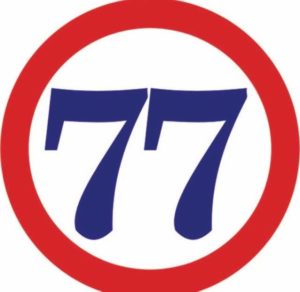
Today is race day. It will be race day in my 77th different country. I’m proud of that achievement. However, I must explain something about that statistic.
Yes, it was racing that brought us to Ukraine. Since this country was being “checked off” today we might never return to Ukraine. Does that mean we don’t like Ukraine? Not in the least!
Long after the racing experience here has faded from our memories other memories with linger. Seeing a first-class ballet in a foreign country is something everyone should do even if they think they will hate going to a ballet.
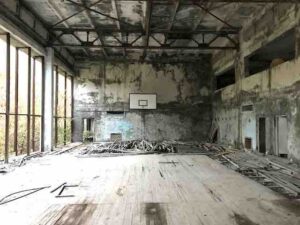
Visiting the site of the Chernobyl nuclear disaster will always be remembered. Tomorrow’s surprise trip (that I haven’t told you about yet) will surely be on the top of our Ukraine memory list.
How many folks get to do what I have described above? Not all that many. However, I haven’t even mentioned the real highlight of the trip. It’s the people. It’s almost always the people.

I had insider knowledge on this trip from Vadym and his friends. For gosh sakes, he had driven out to the airport to pick us up to start the trip. Then we had shared his “pit box” at the races and toured his race shop. As I will tell you, after the races, Vadym and his race team hosted us at a raucous dinner in a “Ukrainian kitchen”. Then the “guys” came up with an idea to make the trackchasing portion of our trip even more robust. However, I might be getting ahead of myself. What happened today?
We started the day by ordering our first ride from Uber. The driver picked us up at the hotel with less than five minutes’ notice. Off we went to the Autodrome Chayka.
Apparently, our Uber driver was not a race fan. The Autodrome Chayka was built all the way back in 1976. I’m pretty sure our driver had never been there. He didn’t speak much English so how do I know that? He got lost driving to the track and had to call Vadym four times to get us there! I’m just glad I had asked Vadym to give me his phone number so drivers and anyone else could call him for help.
By the way, not all that many people speak much English in Ukraine. It seemed like natives of Macedonia were much more familiar with English than Ukraine. Unlike most men as soon as I get lost I stop and ask for directions. When I tried that in Kyiv I more often than not struck out. As you might expect younger people did better than older people with English.
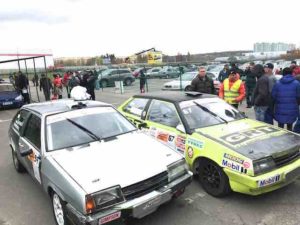
Finally, we reached the Autodrome Chayka. I’m told the racetrack opened in 1976 when Ukraine was actually part of Russia. It’s three kilometers in length or about two miles. Today the cars would be racing counter-clockwise around the road course.
Remember, I provide all of the details you see in this Trackchaser Report just to make it a little easier for my fellow competitors to emulate this trip. By the way, no other trackchaser had ever visited the Autodrome Chayka.
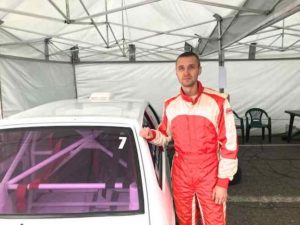
As soon as we reached the paddock area we found Vadym’s pit box. We were soon introduced to Vadym’s co-driver, brother Andrew. Andrew is six years younger than Vadym. Then we got to meet their father and Andrew’s girlfriend and the pit crew and lots of other folks.
The guys would be driving a Russian Lada in today’s one and only race at the track. All of the cars at the track would be in this single race. They don’t normally do that but a couple of the classes had low car counts. Today’s race would be for 40 minutes plus one lap.
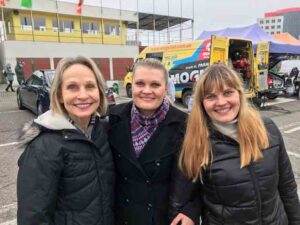
They were just getting ready to go out for qualifying. We would let them go about their racing business. Carol hung out with Andrew’s girlfriend Lena and her twin sister. These three girls, all with roots in Eastern Europe, seemed to have a lot to talk about! I roamed the paddock trying to get photos of each of the racers. The weather was cool with a temperature of 35 degrees Fahrenheit and some wind. Fortunately, the rain that was predicted was holding off. These were not ideal conditions for the race fans. However, on the day I am adding a racetrack in a country for the first time I will take anything I can get.
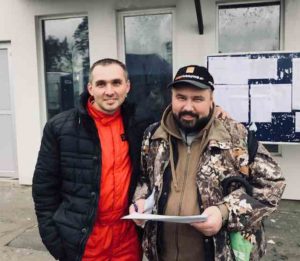
About this time a bearded man came up and introduced himself. He was Slava the “sports observer”. Slava spoke English well. He knew a little bit about my background as a trackchaser. I’m sure he got that initially from Vadym. Slava began to give me some of the background detail about Chayka and today’s race event. However, he had some other interesting news to impart as well.
Slava informed me that some other racing, of a much different sort, was happening in Ukraine this weekend as well. This was country music to my trackchasing ears. Slava told me they were having another race in the city of Rivne, about four hours to the west of Kyiv. It was scheduled for tomorrow. You can imagine what I was thinking at that point.
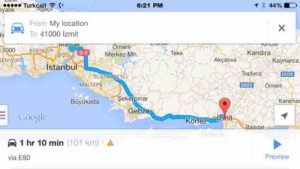
The only time I can ever remember receiving similar news as this happened in nearby Turkey. We had come to Turkey to see racing at their former Formula 1 track, Istanbul Park. Then while talking with our hotel concierge he discovered another track that was holding a race the day after our visit to Istanbul Park.
Wow! Carol and I were all over that even though it wasn’t easy to make happen in Turkey. Imagine trying this in a country like Turkey where English isn’t spoken all that much. We grabbed a taxi to a bus station. This was a city-to-city bus emanating from the huge Istanbul bus terminal. Then when we arrived in the city of Korfez we caught another small bus and then another taxi. It was a wild adventure in a series of many that have come from my hobby of trackchasing. We were happy to add the Izmit Korfez Circuit to our lifetime lists that day.
Being able to add a second track in Ukraine was not going to be easy either. However, if we could make it happen it would be great fun. The biggest challenge in getting over to Rivne was going to be transportation.
Slava had come to me with the idea. Maybe he would like to go and could drive us to the track. Nope. Yes, Slava might like to go but he doesn’t drive.
I told Vadym about the opportunity. Would he like to go? No, he had other plans for Sunday. However, he told me he would check with folks to see what could be done. I never ever entertained the thought of renting a car myself. However, if I had totally struck out with my local contacts I’m sure I would have done that. We would put the Rivne visit on the back burner for a couple of hours. We had racing to watch at the Autodrome Chayka.
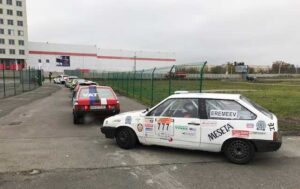
We watched the qualifying from a five-row permanent grandstand. From there we could see the action in the paddock behind the grandstand. On the track, our view was of the 90-degree left-hand turn that led into the long front straight and the start/finish line. Had we been by ourselves we likely would have watched all of the racing from here.
However, Slava was a man of ideas! He recommended we follow him to a special location. From this one viewing point, we would be able to see as much of the track as possible. Not all really good ideas are SAFE ideas.
However, Carol and I are nothing if not adventuresome. We had already been to the heavily radiated Chernobyl Nuclear Disaster site for eight hours. Could watching the race from Slava’s recommended viewing point be any more dangerous than a visit to Chernobyl? The short answer was yes!
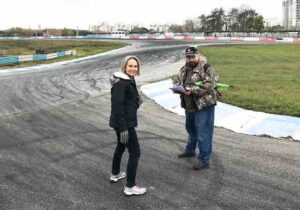
When qualifying was finished and the track was quiet we followed Slava out onto the racecourse. As we walked along he gave us more historical perspective about Chayka’s history and today’s racing. The track had experienced just one fatality when a motorcycle accident happened on a non-racing day.
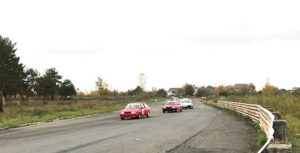
So exactly what did Slava have in mind for us? We would watch the racing from behind a steel Armco safety barrier. The “fence” was just 3-4 feet high and that was it.

He was right about one thing. We could see the racing from the start/finish line and maybe as much as half of the track. Slava did not share the inerrant danger from this spot as much as I did.
Why was I scared? I’m seen a lot of racing at a lot of places. I’ve seen more than my fair share of unusual and deadly wrecks and accidents for both drivers and fans. Today was an accident waiting to happen.
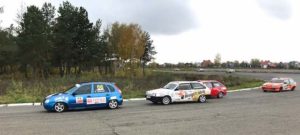
However, we were in Ukraine. Would the U.S. allow a tour as we had just done at Chernobyl? No, they would not. Would normal spectators be allowed to watch racing in the U.S. from the position we found ourselves in today? No, they would not. I guess that’s why we went to Chernobyl and found ourselves in today’s viewing position!
The cars raced on a straight section of the track at very high speeds for about 500 meters directly toward our location. Then they made a sweeping right-hand turn, where the track was slightly banked until they roared out of sight.
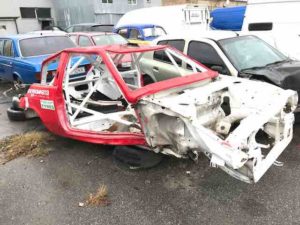
You’re probably thinking, “Randy aren’t you dramatizing the likelihood of your and Carol’s demise just a bit”? When I saw the sections of bent fence that we were standing behind from previous racecar impacts I thought not! Take a look at Vadym’s race car that hit a tree in a previous race.
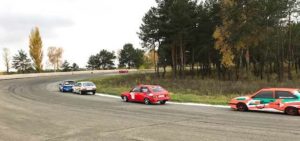
In the right-hand turns the cars put a lot of pressure on their small left front tires. All it would take was one tire failure or a car getting nudged to send one flying in our direction.
I gave Carol implicit instructions. If a car comes our way out of control jump IMMEDIATELY down the hillside banking into the brush. That was a drop of thirty feet or so. I wasn’t sure if this was the best advice or simply hunkering down behind the steel fence and hoping the car would sail over our heads at 70 MPH.
Now before we go any further I must ask my readers a question. I know that some of you are male; probably most, and some are female. Some are married and some are not. At any age could you possibly see yourself suggesting what I was suggesting to Carol of your spouse, significant other, or friend?
We watched most of the race from this spot. I was able to take a lot of good photos and videos. I was the only person taking photos while Slava took notes. Another fellow had a large camera and seemed to be a professional photographer. Today we only nodded and smiled. Tomorrow I would get to meet Igor Romanov.
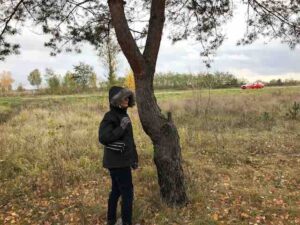
When I thought we had cheated death long enough Carol and I moved around the turn. We were mindful not to take our eyes off the racers. I had the video image of last week’s racing accident in Macedonia firmly planted in my mind. That car got on those victims in a split second. That could happen today as well.

Soon we found ourselves in a wooded area where we had another view of the track. We made sure to stand directly behind some sturdy trees. Vadym had previously sent me a picture of his totally used-up racecar after he had contacted a tree at high speeds at Chayka.
When the cars didn’t come around any longer we assumed the race was over. It had run for 40 minutes and one lap. On the walk back to the paddock area we were reunited with Slava. I’m going to recommend that he not watch the racing from his favorite spot anymore. I would like to have him as a friend for as long as possible.
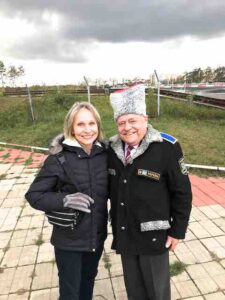
Once back at the paddock we awaited the results. The final results did not come quickly. It seemed that some drivers had broken some rules. One of the rules was that a one-minute minimum pit stop was required. Some drivers, like Vadym and Andrew, co-drove the race. To make things fair, cars driven by just one driver had to make a one-minute pit stop even though they would not have a driver change.

Carol and I stopped by the concession stand for a sandwich and drink while we waited. Then it began to rain. Carol went with Lena to await the final results in her car because of the cold and rain. After about an hour or maybe more the results were in.
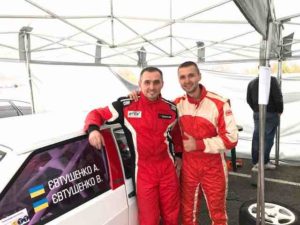
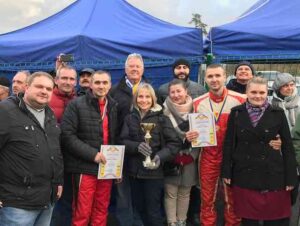
The Evtushenko brothers Vadym and Andrew were declared the winners of their class. Everyone in their pit box was thrilled and happy. It was fun seeing them stand high over the paddock during the podium celebration. Way to go guys! Yes, that’s Carol holding the trophy and me standing right behind her.
It was about this time that Vadym gave me the word on the idea of seeing a race tomorrow in Rivne. One of his pit crewmembers wanted to see that racing. He would drive us. Slava would come along too. That was great trackchasing news.
While we had waited we all drank vodka straight in the paddock. Vadym gave me the opportunity to drive his racecar. I wasn’t sure I could even get in the Lada.
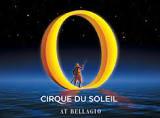
We decided that Vadym would give me a “ride” in the racer. I had to have some assistance getting my last leg shoved in the car. You pretty much have to be an active employee of Cirque de Soleil to get in one of these things. Vadym gave me a pretty exciting ride until the gearbox started smoking and the smell of oil and grease permeated the car’s interior. Then I needed just a little bit more help to untangle my 6’3” frame (190.5 cm) so I could exit the car.
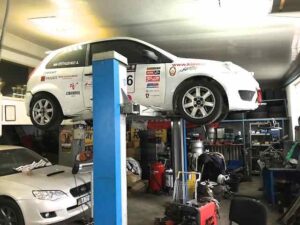
The Evtushenko brothers garage their racecar less than a mile from the track. It seemed as if as many as 15-20 other racers do the same thing in kind of a “condo” like atmosphere.
I guess I first started getting into the racecar garage touring scene when we did it with Allan and Zack Martin in Namibia. Then Nikola Popevski invited us to his garage in Macedonia.
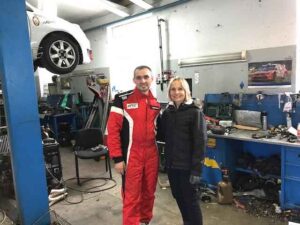
Garage tours are a lot of fun and certainly add a behind-the-scenes element to a fun day of racing. Knowing people who race helped us in so many ways. Major thanks to Vadym and Slava and everyone else for their fine Ukrainian hospitality. They went out of their way to make sure we had a good time. We did.
However, having a Ukrainian good time was not finished for us. Vadym had invited us to join him and his race team for dinner at an authentic “Ukrainian kitchen”.
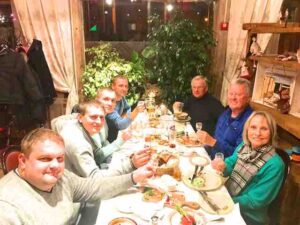
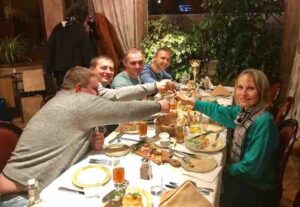
Vadym’s brother Andrew was there. Two members of the pit crew, Denis and Yura joined us. Vadym’s dad, Dmitry, joined us proudly carrying the gold “Cup of Ukraine” trophy. From there the party was on.
All kinds of authentic Ukrainian dishes were offered up. Vadym knew that I had enjoyed khinkali when I had come to nearby Georgia for a trackchasing trip. He made sure to have the Ukraine version of khinkali served. It is called Varenyky.
The boys of Ukraine like to drink as well. We started drinking vodka, again straight, early on in the celebration. This continued during the middle portion of the evening and into the final portion of the evening. From time to time a three-piece Ukrainian band came by to serenade us. As you can imagine the more we drank the more everyone sang along with the band. At random points, when the mood struck anyone at the table, a toast was proposed and more vodka was consumed.
To say everyone had a good time was an understatement. Vadym and his friends and family treated us to a very nice authentic Ukrainian evening of food, fun and entertainment.
Our hotel was only a five-minute walk from the restaurant. Vadym, Denis and Yura volunteered to walk us back to the 11 Mirrors Hotel. There, Carol bade us farewell as we had an early morning wake-up call for tomorrow’s trackchasing activity.
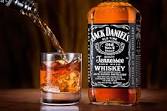
I invited the guys up to the hotel lounge. There we continued to drink alcohol. I had switched to Bailey’s and they went with double shots of Jack Daniels. After two rounds I called it a night. Again, they would not allow me to buy the drinks even in my own hotel. Thanks guys!
Sunday – October 29, 2017
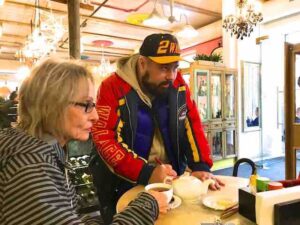
Today might have been the most unexpected surprise I’ve had in years. We had come to Ukraine with the expectation of seeing racing at one track. Yesterday when we arrived at the Autodrome Chayka a fellow came up and introduced himself. He was Slava. Everyone called him the “journalist”. Slava prefers the term, “sports observer” He writes racing reports in Ukraine.
Fortunately, Carol and I didn’t have any absolute firm touring plans for Sunday. The Museum of Corruption and Kyiv city walking tour will have to wait until my second visit to Ukraine. It would have been interesting if we did have some other firm touring plans. Would we have canceled them and gone to the race? You can make your own guess on that.
Vadym came to our rescue. One of his pit crew was willing to drive us eight hours round-trip to Rivne. Slava was in too. Arrangements were made for them to pick us up at our 11 Mirrors Hotel at 8 a.m. on Sunday morning.
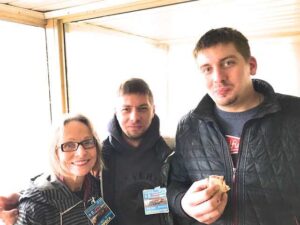
Promptly at 8 a.m. I got a message from Dmitry Parafienko (right). He told me he and his buddy Artyom Sschpotev (center) were waiting downstairs to begin the trip. Then we would make the short drive over to Slava’s home to pick him up.
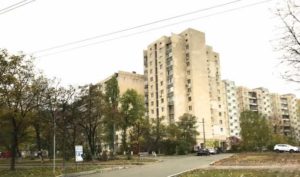
Slava lived in an old-style Soviet era high-rise building. He would describe it as “ghetto”. He lived in his apartment with his grandmother who was in her 90s. Slava told us the place was small at about 20 square meters.
Folks, before I go much further I’ve got to tell you this adventure was a real highlight of the trip. How many foreign visitors to any country get this type of “local flavor” during their visits? I’m going to guess the answer to that question is just about zero.
It took us a bit more than four hours to make the one-way drive. Slava was a pretty good English speaker. Dmitry and Artyom spoke much less English. However, when needed, with a little sign language and short sentences we could all make ourselves understood.
I rarely make long trackchasing driving trips with others besides Carol. Why is that? It’s really rather simple. Other trackchasers can’t keep up with my travel schedule at the beginning or end of one of these trips.
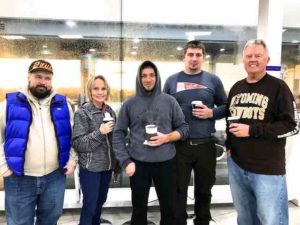
Today Carol was on a “trip with the boys” (Slave, Artyom, Dmitry). The weather was going to be bad. There was a 100% chance of rain. It was cold with temps in the low 40s and windy. There is ZERO chance an American oval track would have raced in these conditions.
I kept asking Slava if he was sure they would race in this weather. He had been talking to the promoter on the phone both yesterday and today and assured me they were racing.
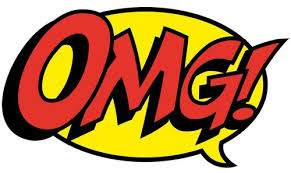
Then after seeing a little bit of the racing action Slava laid this on me. He told me the promoter had asked the drivers if they would like to postpone for a week and wait for better weather. The drivers told him that since they were already at the track they wanted to race. Thank goodness!
Along the way, we stopped at convenience stores for “a coffee” and restroom breaks. Despite much of Ukraine being older and at times not all that prosperous the convenience stores were as nice as the most modern you’ve seen anywhere. Most offered sandwich shops and various forms of coffee and baked goods.
During the four-hour drive, we all learned that Slava is a major NASCAR Cup fan. He’s really a fan of all motorsports. He watches the race on a live streaming basis on his computer.
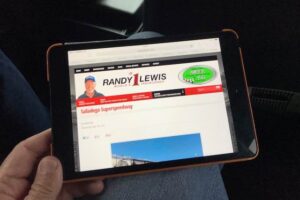
I showed Slava a special section about NASCAR drivers that appears on my website at www.randylewis.org. There I provide my view on each NASCAR Cup driver.
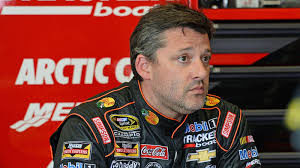
Slava read it with interest from my iPhone. He agreed with most of my analysis with the possible exception of Tony Stewart. Slava could recall virtually every NASCAR incident over the last several years. Yes, he was a major NASCAR fan. By the way, here’s the link to my view of the NASCAR drivers.
NASCAR….my favorite and not so favorite drivers
Racing was scheduled to begin at 2 p.m. Once we arrived in Rivne we had some minor difficulty finding the track. We did see posters advertising the race.
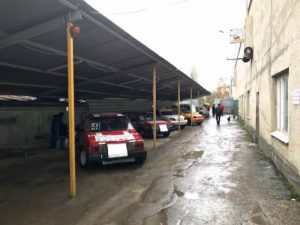
When we did get to the track we pulled into the paddock area first. We found eight smaller, less than 1,600cc, racers parked under a small shelter. Yep! They were going to race today.
We were early. It didn’t look as if any refreshments were being sold at the track today. I suggested we go for pizza. Everyone agreed. With lots of Ukrainian conversation amongst my three new buddies off we went.
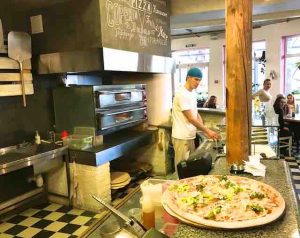
Slava looked like a man who could find a good pizza place. He told us he weighed in at 120 kilograms. He also told us he wasn’t a “sportsman” (athlete). The guys did a great job locating a restaurant serving pizza. Dmitry pulled our car up onto the sidewalk as they do in these parts, and we went inside.
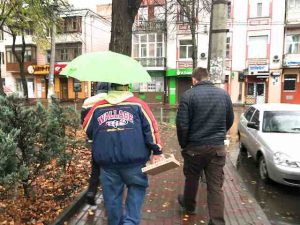
Slava told us we would have to take our pizza to go. There wasn’t time to eat inside the restaurant and still be at the track for the 2 p.m. starting time. We ordered four medium-sized pizzas of different kinds. Service was fast and soon we were back at the track.

The Motorpark Rivne is a large stadium with seating all the way around. I’m going to guess it seated as many as 5,000. Today there might have been twenty racing fans in those stands. There was no admission fee that I could see.
The stadium and its flat dirt oval, about 400 meters in length, normally hosts speedway motorcycles. If you’ve never seen those guys race you should. “Speedway” is very entertaining.
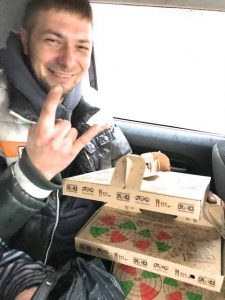

It’s always a good idea to get V.I.P. treatment if you can. Slava knew the promoter. That “in” gave us the use of a “suite” today. The weather conditions were miserable. I’m going to see they were the worst of 2017 for my trackchasing. Our suite provided a nice windbreak although it was not heated. We plopped down our pizza boxes and enjoyed some mighty fine pizza.
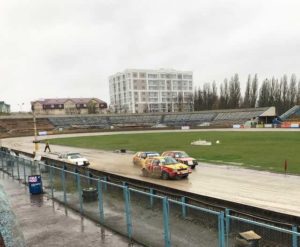
The eight cars racing today were performing in some type of team event. The races would be short only about four laps each. Each of the races would start with three or four cars. The race winner got three points, second two points, etc. At the end of the day, all of the points were totaled up to calculate the day’s overall winner.
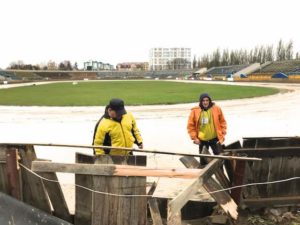
While everyone else stayed in or near our suite I took a walk around the track. With each race’s completion, I would move another section or two around the track. This way I could get photos and videos from every angle.
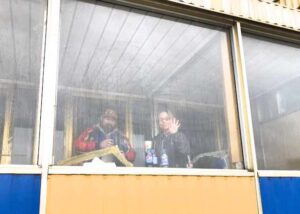
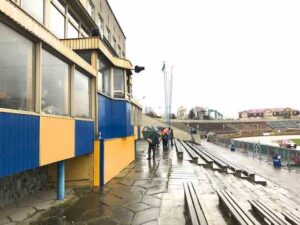
Our suite was located at a nice elevation on the front stretch of the track. The pit area was behind the grandstands on the backstretch. When I reached the pit area on the backside of the track I stopped to say hello to one of the racers.
His name was Igor Romanov. Igor was driving car #0. That’s one of my favorite car numbers made famous by Rick Ferkel and Ernie Schaeffer. I had sort of met Igor at Chayka yesterday. At Chayka, he was taking photos near where we watched the race from. We had nodded and smiled. Today I got to say hello to Mr. Romanov and gave him my trackchasing business card. When I arrived home I had a Facebook friend request from Igor.
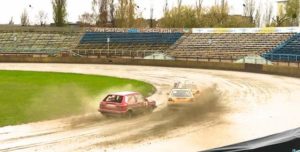
With all of the rain today the track surface was “soupy” at best. In the turns, the cars created large “rooster tails”. A couple of times the cars slid into the wooden board fences that were there to protect the speedway riders.
There weren’t a lot of cars racing today. They didn’t race for very many laps. The weather was bad. Did that affect my enjoyment of the race? Not in the least. Not in the friggin’ least.
I was in Ukraine. Ukraine had been one of the more difficult countries to see a race. The Motorpark Rivne trackchasing idea came up at the last minute. This was a fantastic opportunity to spend some time with three Ukrainian guys I had only met yesterday. Who gets to do that!

I also had the chance to meet today’s promoter, Sergey Peleshok. He was happy to have American racing fans visiting his event. He insisted that he take my picture. I happily obliged. Then I saw the Ukrainian message he sent to his followers about our visit.
“Україна- Америка. Ренді Льюїс гість з Америки відвідав 70 країн 2000 треків. Приємна зустріч в Рівне.”
We had seen about two hours of actual racing. It was at this point that I recommended we head back to Kyiv. It was going to be another four hour plus drive. Carol and I had an early morning wake-up call tomorrow morning for our Kyiv departure. Everyone in our group agreed we had seen what we had come to see. I thanked the promoter and drivers for racing on such a questionable weather day.
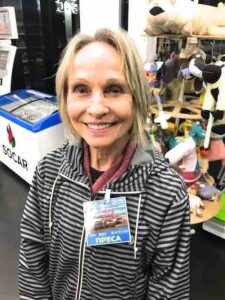
Before I go any further I’ve got to give a shout-out to Carol. She’s a real trooper. Trackchasing is really my hobby. She supports me in it and has seen nearly 600 tracks herself. Would Carol be a trackchaser if I weren’t? You’re kidding with that question, right? Nevertheless, her strategy is that if she’s already out on a trip she wants to see as many tracks as she can. She did that this weekend.
On the way back to our hotel we stopped at another gas station convenience store. There we filled up our car with LPG gas at about $0.50 U.S. per liter. I paid.
During the trip, Slava had entertained us with stories about his model car collection. He showed us pictures. He had thousands of model cars, many of them in their original boxes in his apartment and in his parent’s apartment nearby. The 43-year old also had a collection of more than 400 racing hats. That’s a big collection for a 20 square meter apartment! Slava told me he was a lifetime Jeff Gordon fan although today he was decked out in a Rusty Wallace jacket and hat.

Slava had another interesting point of view. He had been born in Ukraine when it was Russia. That meant he was born a Russian. His primary language is Russian. Most people I met in Ukraine were not fond of Russia. Slava felt differently. Because he was born in Russia and had never left his allegiances were with his native Russia although he was willing to appreciate Ukraine as well.
Everywhere we went in Macedonia and now Ukraine people were giving us gifts and picking up restaurant checks. That was very nice of them.
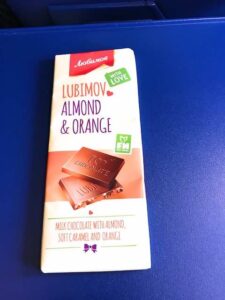
When Slava left our car today he pulled a huge chocolate bar out of his backpack and gave it to us as a gift. Then when we parted ways with Dmitry and Artyom they gave us a small figurine of an old Ukrainian man. Very nice people on this trip. We so much appreciated their kindness and generosity.
Monday – October 30, 2017
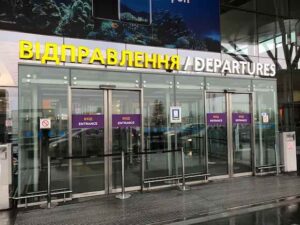
Today it was time to head home. We had left our modest seaside cottage 12 days ago. I’ve had a lot of really good international trips. Frankly, I can’t think of a bad one. Visiting Macedonia and Ukraine joins several other countries at the top of the list.
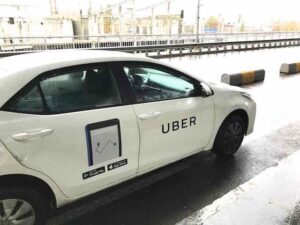
We grabbed an Uber ride to the airport. Initially, our bag was rejected at check-in for being six kilograms “overweight”. We went over to the side and rearranged things. Soon our bag could “make weight”. So where did those magical six kilograms go? I’ll just say it this way. I’ve glad no one tried to pick up my jacket!

On the way home, we would connect in Stockholm, Sweden. We had begun the trip by flying from Los Angeles to Barcelona, Spain to Skopje, Macedonia. In the middle of the trip, we flew from Skopje to Budapest, Hungary to Kyiv, Ukraine. That meant we had been in Spain, Macedonia, Hungary, Ukraine and Sweden on this trip. Does that qualify us as international jet setters?
We landed back at LAX in the evening. While Carol waited for our bag I made the more than one-mile walk from the Tom Bradley International Terminal to our Lot F airport parking garage.

Carol and I celebrated our return to the U.S.A with a visit to In N Out Burgers. This had been virtually a perfect trip. Granted I had put a lot of time into planning it. We were rewarded for those efforts.
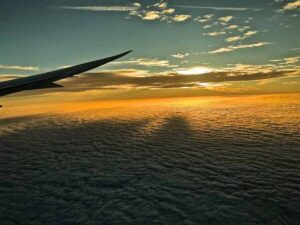
I’ll close my Ukrainian report by thanking Vadym and Slava and everyone else that we met who made our visit to Ukraine one of the best ever. Until next time, long live Ukraine!!!
One might expect that I would just sit back at our modest seaside cottage and watch the sunset over the Pacific Ocean after this long trip. Yes, that would be a good thing to do….but not yet. There’s too much “out there” to see and do. I’m going to see and do it while I can.

Can trackchasing country #78 be far off? It might be far off from San Clemente. It might not be far off in terms of time. Stay tuned right here at www.randylewis.org and you won’t miss a thing.
Thanks for reading about my trackchasing,
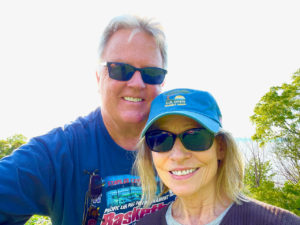
Randy Lewis
World’s #1 Trackchaser
Randy is a freelance journalist who winters in San Clemente, California and sometime flies in coach.
And so it goes from country #77, Ukraine.
THE COUNTRY LIST
#77!!
RLR – Randy Lewis Racing Lifetime Trackchasing Countries
# 1 – UNITED STATES OF AMERICA – Peoria Speedway – Mt. Hawley (oval) – Track #1, Peoria, Illinois – circa 1955
# 2 – CANADA – Cayuga Speedway (oval) – Track #174, Nelles Corner, Ontario – 1988
# 3 – AUSTRALIA – Parramatta City Raceway (oval) – Track #180, Granville, New South Wales – 1989
# 4 – UNITED KINGDOM – Northhampton International Raceway (oval) – Track #378, Northhampton – 1999
# 5 – NETHERLANDS – Driesum Racetrack (oval) – Track #839, Driesum – 2005
# 6 – BELGIUM – Bellekouter oval (oval) – Track #841, Affligem – 2005
# 7 – FRANCE – Circuit de Croix en Ternois (road course) – Track #843, Saint-Pol sur-Ternoise – 2005
# 8 – GERMANY – Nurburgring (road course) – Track #844, Nurburg – 2005
# 9 – NEW ZEALAND – Western Springs Speedway (oval) – Track #1,134, Western Springs – 2006
# 10 – MEXICO – Triovalo Bernardo Obregon (oval) – Track #1,281, Tiajamulco de Zuniga, Jalisco – 2007
# 11 – BARBADOS – Bushy Park Racing Circuit (road course) – Track #1,296, Bushy Park – 2007
# 12 – THAILAND – Bira Circuit (road course) – Track #1,300, Pattaya – 2008
# 13 – SOUTH AFRICA – Durban Grand Prix (road course) – Track #1,315, Durban, KwaZulu-Natal – 2008
# 14 – JAMAICA – Dover Raceway (road course) – Track #1,322, Brown’s Town St. Ann – 2008
# 15 – SWEDEN – Sturup Raceway (road course) – Track #1,335, Malmo – 2008
# 16 – DENMARK – Ring Djursland (road course) – Track #1,336, Tirstrup – 2008
# 17 – CZECH REPUBLIC – Automotodrome BRNO (road course) – Track #1,381, Brno – 2008
# 18 – AUSTRIA – Lambrechten Stock Car Track (road course) – Track #1,382, Lambrechten – 2008
# 19 – IRELAND – Tipperary International Raceway (oval) – Track #1,388, Rosegreen – 2008
# 20 – GUYANA – South Dakota Circuit (road course) – Track #1,390, Timehri – 2008
# 21 – CHINA – The Guia Circuit (road course) – Track #1,392, Macau – 2008
# 22 – COSTA RICA – Autodromo La Guacima (road course) – Track #1,398, La Guacima – 2008
# 23 – ANDORRA – Grandvalira Circuit (road course) – Track #1,404, Port d’Envalira – 2009
# 24 – ARGENTINA – Circuito Efren Chemolli (oval) – Track #1,406, Buenos Aires – 2009
# 25 – QATAR – Losail International Circuit (road course) – Track #1,408, Doha – 2009
# 26 – BAHRAIN – Bahrain International Circuit (road course) – Track #1,410, Sakhir – 2009
# 27 – UNITED ARAB EMIRATES – Dubai Autodrome (road course) – Track #1,411, Dubai – 2009
# 28 – COLOMBIA – Autodromo de Tocancipa (road course) – Track #1,415, Tocancipa – 2009
# 29 – SPAIN – Motorland Aragon (road course) – Track #1,416, Alcaniz – 2009
# 30 – PORTUGAL – Circuto de Murca (road course) – Track #1,417, Murca – 2009
# 31 – ICELAND – Kapelluhraum (road course) – Track #1,420, Hafnafjorour – 2009
# 32 – HUNGARY – Hungaroring (road course) – Track #1,426, Mogyorod – 2009
# 33 – SWITZERLAND – Hock Ybrig (road course) – Track #1,427, Hoch Ybrig – 2009
# 34 – ITALY – Vighizzolo d’Este Stock Car Track (road course) – Track #1,428, Vighizzolo d’Este – 2009
# 35 – DOMINICAN REPUBLIC – Autodromo Mobil 1 (road course) – Track #1,515, Santo Domingo – 2009
# 36 – MALTA – Ta’Qali Race Track (road course) – Track #1,521, Ta’Qali – 2010
# 37 – FINLAND – Lake Pidisjarvi Ice Track (road course) – Track #1,524, Nivala – 2010
# 38 – JAPAN – Suzuka Circuit (road course) – Track #1,530, Suzuka – 2010
# 39 – CHILE – Autodromo de Interlomas (road course) – Track #1,531, Temuco – 2010
# 40 – MOROCCO – Circuit de Marrakesh (road course) – Track #1,535, Marrakesh – 2010
# 41 – BRAZIL – Circuit de Caruaru – Aryten Senna (road course) – Track #1,540, Caruaru – 2010
# 42 – ESTONIA – Laitse Rally Park (road course) – Track #1,571, Laitse – 2010
# 43 – LATVIA – Bikernieki (road course) – Track #1,572, Riga – 2010
# 44 – GUATEMALA – Autodromo Pedro Cofino (road course) – Track #1,580, Alotenango – 2010
# 45 – EL SALVADOR – El Jabali (road course) – Track #1,582, Quezaltepeque – 2010
# 46 – ROMANIA – Bradu (road course) – Track #1,603, Bradu – 2010
# 47 – BULGARIA – Closed Route – Burgas (road course) – Track #1,604, Burgas – 2010
# 48 – SOUTH KOREA – Korea International Circuit (road course) – Track #1,605, Yeongam, Jeollanam-Do – 2010
# 49 – PHILIPPINES – Batangas Racing Circuit (road course) – Track #1,608, Batangas – 2010
# 50 – NORWAY – Lyngas Motorbane (road course) – Track #1,648, Lier – 2011
# 51 – MALAYSIA – Sepang International Circuit (road course) – Track #1,656, Sepang – 2011
# 52 – INDONESIA – Sentul International Circuit (road course) – Track #1,657, Babakan Madang, Boder – 2011
# 53 – LUXEMBOURG – Alzingen (road course) – Track #1,711, Alzingen – 2011
# 54 – POLAND – Tor Slomczyn (road course) – Track #1,713, Slomczyn – 2011
# 55 – SINGAPORE – Marina Bay (road course) – Track #1,714, Singapore – 2011
# 56 – URUGUAY – Piriapolis Grand Prix (road course) – Track #1,724, Piriapolis – 2011
# 57 – SRI LANKA – Pannala Race Track (road course) – Track #1,732, Pannala – 2012
# 58 – ECUADOR – Autodromo Internacional de Yahuarcocha (road course) – Track #1,736, Ibarra – 2012
# 59 – SLOVAKIA – Slovakia Ring (road course) – Track #1,745, Orechova Poten – 2012
# 60 – MONACO – Circuit de Monaco (road course) – Track #1,747, Monte Carlo – 2012
# 61 – CROATIA – Automotodrom Drobnik (road course) – Track #1,762, Rijeka – 2012
# 62 – PERU – Autodromo La Chutana (road course) – Track #1,802, Lima – 2012
# 63 – GREECE – Serres Circuit (road course) – Track #1,807, Serres – 2012
# 64 –RUSSIA – Moscow Central Hippodrome (oval) – Track #1,824, Moscow – 2013
# 65 –LITHUANIA – Marijampole Autocross Track (road course) – Track #1,842, Marijampole – 2013
# 66 –INDIA – Buddh International Circuit (road course) – Track #1,915, Noida – 2013
# 67 –GEORGIA – Rustavi International Motorpark (road course) – Track #1,916, Rustavi – 2013
# 68 –TRINIDAD AND TOBAGO – Larry Gomes Stadium (road course) – Track #1,928, Arima – 2014
# 69 – TURKEY – Istanbul Park (road course) – Track #2,035 Akfirat – 2014
# 70 – AZERBAIJAN – Streets of Baku (road course) – Track #2,037, Baku – 2014
# 71 – SERBIA – Usce (road course) – Track #2,224, Belgrade – 2016
# 72 – BOSNIA AND HERZEGOVNIA – Zaluzani (road course) – Track #2,235, Banja Luka – 2016
# 73 – PANAMA – Circuito Internacional de Panama (road course) – Track #2,290, La Chorrera – 2016
# 74 – ZIMBABWE – Bulawayo Motorsports Park (road course) – Track #2,291, Bulawayo – 2016
# 75 – NAMIBIA – Desert Raceway (oval) – Track #2,369, Walvis Bay – 2017
# 76 – MACEDONIA – Skopje Street Course (road course) – Track #2,386, Skopje – 2017
# 77 – UKRAINE – Autodrome Chayka (road course) – Track #2,387, Kiev – 2017
The International Big 3.
- . Randy Lewis, San Clemente, California USA – 77
- . Roland Vanden Eynde, Vilvoorde, Belgium – 52
- . Carol Lewis, San Clemente, California USA – 42
It took me a while to get going with my “new country” visits for 2017. However, when I finally did get things started it was with a vengeance. I have now completed all of my new trackchasing country visits for the year. No trackchaser has ever seen racing in Namibia or Macedonia until now. Ukraine is now added to my list as well. Yep. The year 2017 has turned into a great international trackchasing year.
LIFETIME TRACKCHASER COMPARISONS
The three most important trackchasing comparisons to me are:
Total lifetime tracks seen
Total “trackchasing countries” seen
Lifetime National Geographic Diversity results
Total Lifetime Tracks
There are no trackchasers currently within 600 tracks of my lifetime total. Don’t blame me.
- . Randy Lewis, San Clemente, California – 2,388
Total Trackchasing Countries
There are no trackchasers currently within 20 countries of my lifetime total.
- . Randy Lewis, San Clemente, California – 77
Current lifetime National Geographic Diversity results
- Randy Lewis, San Clemente, California – 4.47
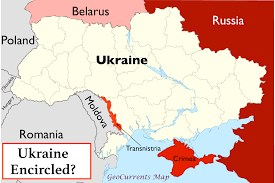
Ukraine – FAST FACTS*
Provided by my friends at Wikipedia
Ukraine, sometimes called the Ukraine, is a sovereign state in Eastern Europe, bordered by Russia to the east and northeast, Belarus to the northwest, Poland, Hungary and Slovakia to the west, Romania, and Moldova to the southwest, and the Black Sea and Sea of Azov to the south and southeast, respectively. Ukraine is currently in territorial dispute with Russia over the Crimean Peninsula which Russia annexed in 2014 but which Ukraine and most of the international community recognise as Ukrainian. Including Crimea, Ukraine has an area of 603,628 km2 (233,062 sq mi), making it the largest country entirely within Europe and the 46th largest country in the world. Excluding Crimea, Ukraine has a population of about 42.5 million, making it the 32nd most populous country in the world.
During the 20th century three periods of independence occurred. The first of these periods occurred briefly during and immediately after the German occupation near the end of World War I and the second occurred, also briefly, and also during German occupation, during World War II. However, both of these first two earlier periods would eventually see Ukraine’s territories consolidated back into a Soviet republic within the USSR. The third period of independence began in 1991, when Ukraine gained its independence from the Soviet Union in the aftermath of its dissolution at the end of the Cold War.
Ukraine has maintained its independence as a sovereign state ever since. Before its independence, Ukraine was typically referred to in English as “The Ukraine”, but sources since then have moved to drop “the” from the name of Ukraine in all uses.
Following its independence, Ukraine declared itself a neutral state. Nonetheless it formed a limited military partnership with the Russian Federation and other CIS countries and a partnership with NATO in 1994. In the 2000s, the government began leaning towards NATO, and a deeper cooperation with the alliance was set by the NATO-Ukraine Action Plan signed in 2002. It was later agreed that the question of joining NATO should be answered by a national referendum at some point in the future. Former President Viktor Yanukovych considered the current level of co-operation between Ukraine and NATO sufficient, and was against Ukraine joining NATO. In 2013, after the government of President Yanukovych had decided to suspend the Ukraine-European Union Association Agreement and seek closer economic ties with Russia, a several-months-long wave of demonstrations and protests known as the Euromaidan began, which later escalated into the 2014 Ukrainian revolution that led to the overthrow of President Yanukovych and his cabinet and the establishment of a new government.
These events formed the background for the annexation of Crimea by Russia in March 2014, and the War in Donbass in April 2014. On 1 January 2016, Ukraine applied the economic part of the Deep and Comprehensive Free Trade Area with the European Union.
Ukraine has long been a global breadbasket because of its extensive, fertile farmlands and is one of the world’s largest grain exporters. The diversified economy of Ukraine includes a large heavy industry sector, particularly in aerospace and industrial equipment.
Ukraine is a unitary republic under a semi-presidential system with separate powers: legislative, executive and judicial branches. Its capital and largest city is Kiev. Taking into account reserves and paramilitary personnel, Ukraine maintains the second-largest military in Europe after that of Russia. The country is home to 42.5 million people (excluding Crimea), 77.8 percent of whom are Ukrainians “by ethnicity”, followed by a sizeable minority of Russians (17.3 percent) as well as Romanians/Moldovans, Belarusians, Crimean Tatars, Bulgarians and Hungarians. Ukrainian is the official language and its alphabet is Cyrillic. The dominant religion in the country is Eastern Orthodoxy, which has strongly influenced Ukrainian architecture, literature and music. It is a member of the United Nations since its founding, the Council of Europe, OSCE, GUAM, and one of the founding states of the Commonwealth of Independent States (CIS).
Ukrainians entered World War I on the side of both the Central Powers, under Austria, and the Triple Entente, under Russia. 3.5 million Ukrainians fought with the Imperial Russian Army, while 250,000 fought for the Austro-Hungarian Army. Austro-Hungarian authorities established the Ukrainian Legion to fight against the Russian Empire. This became the Ukrainian Galician Army that fought against the Bolsheviks and Poles in the post-World War I period (1919–23). Those suspected of Russophile sentiments in Austria were treated harshly.
World War I destroyed both empires. The Russian Revolution of 1917 led to the founding of the Soviet Union under the Bolsheviks, and subsequent civil war in Russia. A Ukrainian national movement for self-determination re-emerged, with heavy Communist and Socialist influence. Several Ukrainian states briefly emerged: the internationally recognized Ukrainian People’s Republic (UNR, the predecessor of modern Ukraine, was declared on 23 June 1917 proclaimed at first as a part of the Russian Republic; after the Bolshevik Revolution, the Ukrainian People’s Republic proclaimed its independence on 25 January 1918), the Hetmanate, the Directorate and the pro-Bolshevik Ukrainian Soviet Socialist Republic (or Soviet Ukraine) successively established territories in the former Russian Empire; while the West Ukrainian People’s Republic and the Hutsul Republic emerged briefly in the Ukrainian lands of former Austro-Hungarian territory.
Act Zluky (Unification Act) was an agreement signed on January 22, 1919 by the Ukrainian People’s Republic and the West Ukrainian People’s Republic on the St. Sophia Square in Kiev.
This led to civil war, and an anarchist movement called the Black Army or later The Revolutionary Insurrectionary Army of Ukraine developed in Southern Ukraine under the command of the anarchist Nestor Makhno during the Russian Civil War. They protected the operation of “free soviets” and libertarian communes in the Free Territory, an attempt to form a stateless anarchist society from 1918 to 1921 during the Ukrainian Revolution, fighting both the tsarist White Army under Denikin and later the Red Army under Trotsky, before being defeated by the latter in August 1921.
Poland defeated Western Ukraine in the Polish-Ukrainian War, but failed against the Bolsheviks in an offensive against Kiev. According to the Peace of Riga, western Ukraine was incorporated into Poland, which in turn recognised the Ukrainian Soviet Socialist Republic in March 1919. With establishment of the Soviet power, Ukraine lost half of its territory to Poland, Belarus and Russia, while on the left bank of Dniester River was created Moldavian autonomy. Ukraine became a founding member of the Union of Soviet Socialist Republics in December 1922.
The war in Ukraine continued for another two years; by 1921, however, most of Ukraine had been taken over by the Soviet Union, while Galicia and Volhynia (West Ukraine) were incorporated into independent Poland. Bukovina was annexed by Romania and Carpathian Ruthenia was admitted to the Czechoslovak Republic as an autonomy.
A powerful underground Ukrainian nationalist movement arose in Poland in the 1920s and 1930s because of Polish national policies, which was led by the Ukrainian Military Organization and the Organisation of Ukrainian Nationalists (OUN). The movement attracted a militant following among students. Hostilities between Polish state authorities and the popular movement led to a substantial number of fatalities, and the autonomy which had been promised was never implemented. A number of Ukrainian parties, the Ukrainian Catholic Church, an active press, and a business sector existed in Poland. Economic conditions improved in the 1920s, but the region suffered from the Great Depression in the 1930s.
The Russian Civil War devastated the whole Russian Empire including Ukraine. It left over 1.5 million people dead and hundreds of thousands homeless in the former Russian Empire territory. Soviet Ukraine also faced the Russian famine of 1921 (primarily affecting the Russian Volga-Ural region). During the 1920s, under the Ukrainisation policy pursued by the national Communist leadership of Mykola Skrypnyk, Soviet leadership encouraged a national renaissance in the Ukrainian culture and language. Ukrainisation was part of the Soviet-wide policy of Korenisation (literally indigenisation). The Bolsheviks were also committed to universal health care, education and social-security benefits, as well as the right to work and housing. Women’s rights were greatly increased through new laws. Most of these policies were sharply reversed by the early 1930s after Joseph Stalin became the de facto communist party leader.
Starting from the late 1920s with a centrally planned economy, Ukraine was involved in Soviet industrialisation and the republic’s industrial output quadrupled during the 1930s. The peasantry suffered from the programme of collectivisation of agriculture which began during and was part of the first five-year plan and was enforced by regular troops and secret police. Those who resisted were arrested and deported and agricultural productivity greatly declined.
As members of the collective farms were sometimes not allowed to receive any grain until unrealistic quotas were met, millions starved to death in a famine known as the Holodomor or the “Great Famine”.
Scholars are divided as to whether this famine fits the definition of genocide, but the Ukrainian parliament and the governments of other countries have acknowledged it as such.
The Communist leadership perceived famine as a means of class struggle and used starvation as a punishment tool to force peasants into collective farms.
Largely the same groups were responsible for the mass killing operations during the civil war, collectivisation, and the Great Terror. These groups were associated with Yefim Yevdokimov (1891–1939) and operated in the Secret Operational Division within General State Political Administration (OGPU) in 1929–31. Evdokimov transferred into Communist Party administration in 1934, when he became Party secretary for North Caucasus Krai. He appears to have continued advising Joseph Stalin and Nikolai Yezhov on security matters, and the latter relied on Evdokimov’s former colleagues to carry out the mass killing operations that are known as the Great Terror in 1937–38.
On 13 January 2010, Kiev Appellate Court posthumously found Stalin, Kaganovich and other Soviet Communist Party functionaries guilty of genocide against Ukrainians during the Holodomor famine.
Following the Invasion of Poland in September 1939, German and Soviet troops divided the territory of Poland. Thus, Eastern Galicia and Volhynia with their Ukrainian population became part of Ukraine. For the first time in history, the nation was united.
In 1940, the Soviets annexed Bessarabia and northern Bukovina. The Ukrainian SSR incorporated the northern and southern districts of Bessarabia, northern Bukovina, and the Hertsa region. But it ceded the western part of the Moldavian Autonomous Soviet Socialist Republic to the newly created Moldavian Soviet Socialist Republic. These territorial gains of the USSR were internationally recognized by the Paris peace treaties of 1947.
German armies invaded the Soviet Union on 22 June 1941, initiating nearly four years of total war. The Axis initially advanced against desperate but unsuccessful efforts of the Red Army. In the encirclement battle of Kiev, the city was acclaimed as a “Hero City”, because of its fierce resistance. More than 600,000 Soviet soldiers (or one-quarter of the Soviet Western Front) were killed or taken captive there, with many suffering severe mistreatment.
Although the majority of Ukrainians fought in or alongside the Red Army and Soviet resistance, in Western Ukraine an independent Ukrainian Insurgent Army movement arose (UPA, 1942). Created as forces of the Ukrainian Government in exile, it fell under the influence of the underground (Organization of Ukrainian Nationalists, OUN) which had developed in interwar Poland as a radical reaction to Polish policies towards the Ukrainian minority. Both supported the goal of an independent Ukrainian state on the territory with a Ukrainian ethnic majority.
Although this brought conflict with Nazi Germany, at times the Melnyk wing of the OUN allied with the Nazi forces. Some UPA divisions also carried out massacres of ethnic Poles, which brought reprisals.
Kyiv suffered significant damage during World War II, and was occupied by Nazi Germany from 19 September 1941 until 6 November 1943.
In total, the number of ethnic Ukrainians who fought in the ranks of the Soviet Army is estimated from 4.5 million to 7 million. The pro-Soviet partisan guerrilla resistance in Ukraine is estimated to number at 47,800 from the start of occupation to 500,000 at its peak in 1944, with about 50% being ethnic Ukrainians.
Most of the Ukrainian SSR was organised within the Reichskommissariat Ukraine, with the intention of exploiting its resources and eventual German settlement. Some western Ukrainians, who had only joined the Soviet Union in 1939, hailed the Germans as liberators. Brutal German rule eventually turned their supporters against the Nazi administrators, who made little attempt to exploit dissatisfaction with Stalinist policies. Instead, the Nazis preserved the collective-farm system, carried out genocidal policies against Jews, deported millions of people to work in Germany, and began a depopulation program to prepare for German colonisation. They blockaded the transport of food on the Kiev River.
The vast majority of the fighting in World War II took place on the Eastern Front. By some estimates, 93% of all German casualties took place there. The total losses inflicted upon the Ukrainian population during the war are estimated at between 5 and 8 million, including an estimated one and a half million Jews killed by the Einsatzgruppen, sometimes with the help of local collaborators. Of the estimated 8.7 million Soviet troops who fell in battle against the Nazis, 1.4 million were ethnic Ukrainians. Victory Day is celebrated as one of ten Ukrainian national holidays.
Post-World War II
The republic was heavily damaged by the war, and it required significant efforts to recover. More than 700 cities and towns and 28,000 villages were destroyed. The situation was worsened by a famine in 1946–47, which was caused by a drought and the wartime destruction of infrastructure. The death toll of this famine varies, with even the lowest estimate in the tens of thousands. In 1945, the Ukrainian SSR became one of the founding members of the United Nations organization, part of a special agreement at the Yalta Conference.
Post-war ethnic cleansing occurred in the newly expanded Soviet Union. As of 1 January 1953, Ukrainians were second only to Russians among adult “special deportees”, comprising 20% of the total. In addition, over 450,000 ethnic Germans from Ukraine and more than 200,000 Crimean Tatars were victims of forced deportations.
Following the death of Stalin in 1953, Nikita Khrushchev became the new leader of the USSR. Having served as First Secretary of the Communist Party of Ukrainian SSR in 1938–49, Khrushchev was intimately familiar with the republic; after taking power union-wide, he began to emphasize “the friendship” between the Ukrainian and Russian nations. In 1954, the 300th anniversary of the Treaty of Pereyaslav was widely celebrated. Crimea was transferred from the Russian SFSR to the Ukrainian SSR.
By 1950, the republic had fully surpassed pre-war levels of industry and production. During the 1946–1950 five-year plan, nearly 20% of the Soviet budget was invested in Soviet Ukraine, a 5% increase from pre-war plans. As a result, the Ukrainian workforce rose 33.2% from 1940 to 1955 while industrial output grew 2.2 times in that same period.
Soviet Ukraine soon became a European leader in industrial production, and an important centre of the Soviet arms industry and high-tech research. Such an important role resulted in a major influence of the local elite. Many members of the Soviet leadership came from Ukraine, most notably Leonid Brezhnev. He later ousted Khrushchev and became the Soviet leader from 1964 to 1982. Many prominent Soviet sports players, scientists, and artists came from Ukraine.
On 26 April 1986, a reactor in the Chernobyl Nuclear Power Plant exploded, resulting in the Chernobyl disaster, the worst nuclear reactor accident in history. This was the only accident to receive the highest possible rating of 7 by the International Nuclear Event Scale, indicating a “major accident”, until the Fukushima Daiichi nuclear disaster in March 2011.
At the time of the accident, 7 million people lived in the contaminated territories, including 2.2 million in Ukraine.
After the accident, the new city of Slavutych was built outside the exclusion zone to house and support the employees of the plant, which was decommissioned in 2000. A report prepared by the International Atomic Energy Agency and World Health Organization attributed 56 direct deaths to the accident and estimated that there may have been 4,000 extra cancer deaths.
Independence
On 16 July 1990, the new parliament adopted the Declaration of State Sovereignty of Ukraine. This established the principles of the self-determination, democracy, independence, and the priority of Ukrainian law over Soviet law. A month earlier, a similar declaration was adopted by the parliament of the Russian SFSR. This started a period of confrontation with the central Soviet authorities. In August 1991, a faction among the Communist leaders of the Soviet Union attempted a coup to remove Mikhail Gorbachev and to restore the Communist party’s power. After it failed, on 24 August 1991 the Ukrainian parliament adopted the Act of Independence.
A referendum and the first presidential elections took place on 1 December 1991. More than 90% of the electorate expressed their support for the Act of Independence, and they elected the chairman of the parliament, Leonid Kravchuk as the first President of Ukraine. At the meeting in Brest, Belarus on 8 December, followed by the Alma Ata meeting on 21 December, the leaders of Belarus, Russia, and Ukraine formally dissolved the Soviet Union and formed the Commonwealth of Independent States (CIS).
Ukraine was initially viewed as having favourable economic conditions in comparison to the other regions of the Soviet Union. However, the country experienced deeper economic slowdown than some of the other former Soviet Republics. During the recession, Ukraine lost 60% of its GDP from 1991 to 1999, and suffered five-digit inflation rates.
Dissatisfied with the economic conditions, as well as the amounts of crime and corruption in Ukraine, Ukrainians protested and organized strikes.
The Ukrainian economy stabilized by the end of the 1990s. A new currency, the hryvnia, was introduced in 1996. After 2000, the country enjoyed steady real economic growth averaging about seven percent annually.
A new Constitution of Ukraine was adopted under second President Leonid Kuchma in 1996, which turned Ukraine into a semi-presidential republic and established a stable political system. Kuchma was, however, criticised by opponents for corruption, electoral fraud, discouraging free speech and concentrating too much power in his office.
Ukraine also pursued full nuclear disarmament, giving up the third largest nuclear weapons stockpile in the world and dismantling or removing all strategic bombers on its territory in exchange for various assurances (main article: Nuclear weapons and Ukraine).
Orange Revolution
In 2004, Viktor Yanukovych, then Prime Minister, was declared the winner of the presidential elections, which had been largely rigged, as the Supreme Court of Ukraine later ruled. The results caused a public outcry in support of the opposition candidate, Viktor Yushchenko, who challenged the outcome. During the tumultuous months of the revolution, candidate Yushchenko suddenly became gravely ill, and was soon found by multiple independent physician groups, to have been poisoned by TCDD dioxin.
Yushchenko strongly suspected Russian involvement in his poisoning. All of this eventually resulted in the peaceful Orange Revolution, bringing Viktor Yushchenko and Yulia Tymoshenko to power, while casting Viktor Yanukovych in opposition.
Euromaidan and 2014 revolution
The Euromaidan protests started in November 2013 after the president, Viktor Yanukovych, began moving away from an association agreement that had been in the works with the European Union and instead chose to establish closer ties with the Russian Federation. Some Ukrainians took to the streets to show their support for closer ties with Europe. Meanwhile, in the predominantly Russian-speaking east, a large portion of the population opposed the Euromaidan protests, instead supporting the Yanukovych government.
Over time, Euromaidan came to describe a wave of demonstrations and civil unrest in Ukraine, the scope of which evolved to include calls for the resignation of President Yanukovych and his government.
Violence escalated after 16 January 2014 when the government accepted new Anti-Protest Laws. Violent anti-government demonstrators occupied buildings in the centre of Kiev, including the Justice Ministry building, and riots left 98 dead with approximately fifteen thousand injured and 100 considered missing from 18 to 20 February. Owing to the violent protests, Members of Parliament voted on 22 February to remove the president and set an election for 25 May to select his replacement. Petro Poroshenko, running on a pro-European Union platform, won with over fifty percent of the vote, therefore not requiring a run-off election. Upon his election, Poroshenko announced that his immediate priorities would be to take action in the civil unrest in Eastern Ukraine and mend ties with the Russian Federation. Poroshenko was inaugurated as president on 7 June 2014, as previously announced by his spokeswoman Irina Friz in a low-key ceremony without a celebration on Kiev’s Maidan Nezalezhnosti square (the centre of the Euromaidan protests for the ceremony. In October 2014 Parliament elections, Petro Poroshenko Bloc “Solidarity” won 132 of the 423 contested seats.
Civil unrest and Russian intervention
The ousting of Yanukovych prompted Vladimir Putin to begin preparations to annex Crimea on 23 February 2014. Using the Russian naval base at Sevastopol as cover, Putin directed Russian troops and intelligence agents to disarm Ukrainian forces and take control of Crimea. After the troops entered Crimea, a controversial referendum was held on 16 March 2014 and the official result was that 97 percent wished to join with Russia. On 18 March 2014, Russia and the self-proclaimed Republic of Crimea signed a treaty of accession of the Republic of Crimea and Sevastopol in the Russian Federation. The UN general assembly responded by passing resolution 68/262 that the referendum was invalid and supporting the territorial integrity of Ukraine.
Talks in Geneva between the EU, Russia, Ukraine and USA yielded a Joint Diplomatic Statement referred to as the 2014 Geneva Pact in which the parties requested that all unlawful militias lay down their arms and vacate seized government buildings, and also establish a political dialogue that could lead to more autonomy for Ukraine’s regions. When Petro Poroshenko won the presidential election held on 25 May 2014, he vowed to continue the military operations by the Ukrainian government forces to end the armed insurgency. More than 9,000 people have been killed in the military campaign.
In August 2014, a bilateral commission of leading scholars from the United States and Russia issued the Boisto Agenda indicating a 24-step plan to resolve the crisis in Ukraine. The Boisto Agenda was organized into five imperative categories for addressing the crisis requiring stabilization identified as: (1) Elements of an Enduring, Verifiable Ceasefire; (2) Economic Relations; (3) Social and Cultural Issues; (4) Crimea; and, (5) International Status of Ukraine. In late 2014, Ukraine ratified the Ukraine–European Union Association Agreement, which Poroshenko described as Ukraine’s “first but most decisive step” towards EU membership.Poroshenko also set 2020 as the target for EU membership application.
In February 2015, after a summit hosted in Belarus, Poroshenko negotiated a ceasefire with the separatist troops. This included conditions such as the withdrawal of heavy weaponry from the front line and decentralisation of rebel regions by the end of 2015. It also included conditions such as Ukrainian control of the border with Russia in 2015 and the withdrawal of all foreign troops from Ukrainian territory. The ceasefire began at midnight on 15 February 2015.
Participants in this ceasefire also agreed to attend regular meetings to ensure that the agreement is respected. On 1 January 2016, Ukraine joined the Deep and Comprehensive Free Trade Area with European Union, which aims to modernize and develop Ukraine’s economy, governance and rule of law to EU standards and gradually increase integration with the EU Internal market.
Geography
At 603,628 square kilometres (233,062 sq mi) and with a coastline of 2,782 kilometres (1,729 mi), Ukraine is the world’s 46th-largest country (after South Sudan and before Madagascar). It is the largest wholly European country and the second-largest country in Europe (after the European part of Russia, before metropolitan France). The country’s only mountains are the Carpathian Mountains in the west, of which the highest is the Hora Hoverla at 2,061 metres (6,762 ft), and the Crimean Mountains on Crimea, in the extreme south along the coast.
Significant natural resources in Ukraine include iron ore, coal, manganese, natural gas, oil, salt, sulphur, graphite, titanium, magnesium, kaolin, nickel, mercury, timber and an abundance of arable land. Despite this, the country faces a number of major environmental issues such as inadequate supplies of potable water; air- and water-pollution and deforestation, as well as radiation contamination in the north-east from the 1986 accident at the Chernobyl Nuclear Power Plant. Recycling toxic household waste is still in its infancy in Ukraine.
Biodiversity
Ukraine is home to a very wide range of animals, fungi, microorganisms and plants.
Animals
Ukraine is divided into two main zoological areas. One of these areas, in the west of the country, is made up of the borderlands of Europe, where there are species typical of mixed forests, the other is located in eastern Ukraine, where steppe-dwelling species thrive. In the forested areas of the country it is not uncommon to find lynxes, wolves, wild boar and martens, as well as many other similar species; this is especially true of the Carpathian Mountains, where a large number of predatory mammals make their home, as well as a contingent of brown bears. Around Ukraine’s lakes and rivers beavers, otters and mink make their home, whilst in the waters carp, bream and catfish are the most commonly found species of fish. In the central and eastern parts of the country, rodents such as hamsters and gophers are found in large numbers.
Climate
Ukraine has a mostly temperate climate, with the exception of the southern coast of Crimea which has a subtropical climate. The climate is influenced by moderately warm, humid air coming from the Atlantic Ocean. Average annual temperatures range from 5.5–7 °C (41.9–44.6 °F) in the north, to 11–13 °C (51.8–55.4 °F) in the south. Precipitation is disproportionately distributed; it is highest in the west and north and lowest in the east and southeast.
Western Ukraine, particularly in the Carpathian Mountains, receives around 1,200 millimetres (47.2 in) of precipitation annually, while Crimea and the coastal areas of the Black Sea receive around 400 millimetres (15.7 in).
Politics
Ukraine is a republic under a mixed semi-parliamentary semi-presidential system with separate legislative, executive, and judicial branches.
Constitution of Ukraine
With the proclamation of its independence on 24 August 1991, and adoption of a constitution on 28 June 1996, Ukraine became a semi-presidential republic. However, in 2004, deputies introduced changes to the Constitution, which tipped the balance of power in favour of a parliamentary system. From 2004 to 2010, the legitimacy of the 2004 Constitutional amendments had official sanction, both with the Constitutional Court of Ukraine, and most major political parties. Despite this, on 30 September 2010 the Constitutional Court ruled that the amendments were null and void, forcing a return to the terms of the 1996 Constitution and again making Ukraine’s political system more presidential in character.
The ruling on the 2004 Constitutional amendments became a major topic of political discourse. Much of the concern was based on the fact that neither the Constitution of 1996 nor the Constitution of 2004 provided the ability to “undo the Constitution”, as the decision of the Constitutional Court would have it, even though the 2004 constitution arguably has an exhaustive list of possible procedures for constitutional amendments (articles 154–159). In any case, the current Constitution could be modified by a vote in Parliament.
On 21 February 2014 an agreement between President Viktor Yanukovych and opposition leaders saw the country return to the 2004 Constitution. The historic agreement, brokered by the European Union, followed protests that began in late November 2013 and culminated in a week of violent clashes in which scores of protesters were killed. In addition to returning the country to the 2004 Constitution, the deal provided for the formation of a coalition government, the calling of early elections, and the release of former Prime Minister Yulia Tymoshenko from prison. A day after the agreement was reached the Ukraine parliament dismissed Yanukovych and installed its speaker Oleksandr Turchynov as interim president and Arseniy Yatsenyuk as the Prime Minister of Ukraine.
President, parliament and government
The President is elected by popular vote for a five-year term and is the formal head of state. Ukraine’s legislative branch includes the 450-seat unicameral parliament, the Verkhovna Rada. The parliament is primarily responsible for the formation of the executive branch and the Cabinet of Ministers, headed by the Prime Minister. However, the President still retains the authority to nominate the Ministers of the Foreign Affairs and of Defence for parliamentary approval, as well as the power to appoint the Prosecutor General and the head of the Security Service.
The Supreme Court is the main body in the system of courts of general jurisdiction. Local self-government is officially guaranteed. Local councils and city mayors are popularly elected and exercise control over local budgets.
Ukraine has a large number of political parties, many of which have tiny memberships and are unknown to the general public. Small parties often join in multi-party coalitions (electoral blocs) for the purpose of participating in parliamentary elections.
Courts and law enforcement
The courts enjoy legal, financial and constitutional freedom guaranteed by Ukrainian law since 2002. Judges are largely well protected from dismissal (except in the instance of gross misconduct). Court justices are appointed by presidential decree for an initial period of five years, after which Ukraine’s Supreme Council confirms their positions for life. Although there are still problems, the system is considered to have been much improved since Ukraine’s independence in 1991. The Supreme Court is regarded as an independent and impartial body, and has on several occasions ruled against the Ukrainian government. The World Justice Project ranks Ukraine 66 out of 99 countries surveyed in its annual Rule of Law Index.
National Police of Ukraine was formed on 3 July 2015, as part of the post-Euromaidan reforms.
Prosecutors in Ukraine have greater powers than in most European countries, and according to the European Commission for Democracy through Law ‘the role and functions of the Prosecutor’s Office is not in accordance with Council of Europe standards”. The criminal judicial system maintains an average conviction rate of over 99%, equal to the conviction rate of the Soviet Union, with suspects often being incarcerated for long periods before trial. On 24 March 2010, President Yanukovych formed an expert group to make recommendations how to “clean up the current mess and adopt a law on court organization”. One day later, he stated “We can no longer disgrace our country with such a court system.” The criminal judicial system and the prison system of Ukraine remain quite punitive.
Since 1 January 2010 it has been permissible to hold court proceedings in Russian by mutual consent of the parties. Citizens unable to speak Ukrainian or Russian may use their native language or the services of a translator. Previously all court proceedings had to be held in Ukrainian.
Law enforcement agencies in Ukraine are organised under the authority of the Ministry of Internal Affairs. They consist primarily of the national police force and various specialised units and agencies such as the State Border Guard and the Coast Guard services. Law enforcement agencies, particularly the police, faced criticism for their heavy handling of the 2004 Orange Revolution. Many thousands of police officers were stationed throughout the capital, primarily to dissuade protesters from challenging the state’s authority but also to provide a quick reaction force in case of need; most officers were armed. Bloodshed was only avoided when Lt. Gen. Sergei Popkov heeded his colleagues’ calls to withdraw.
The Ministry of Internal Affairs is also responsible for the maintenance of the State Security Service; Ukraine’s domestic intelligence agency, which has on occasion been accused of acting like a secret police force serving to protect the country’s political elite from media criticism. On the other hand, however, it is widely accepted that members of the service provided vital information about government plans to the leaders of the Orange Revolution to prevent the collapse of the movement.
Foreign relations
In 1999–2001, Ukraine served as a non-permanent member of the UN Security Council. Historically, Soviet Ukraine joined the United Nations in 1945 as one of the original members following a Western compromise with the Soviet Union, which had asked for seats for all 15 of its union republics. Ukraine has consistently supported peaceful, negotiated settlements to disputes. It has participated in the quadripartite talks on the conflict in Moldova and promoted a peaceful resolution to conflict in the post-Soviet state of Georgia. Ukraine also has made a substantial contribution to UN peacekeeping operations since 1992.
Ukraine currently considers Euro-Atlantic integration its primary foreign policy objective, but in practice it has always balanced its relationship with the European Union and the United States with strong ties to Russia. The European Union’s Partnership and Cooperation Agreement (PCA) with Ukraine went into force on 1 March 1998. The European Union (EU) has encouraged Ukraine to implement the PCA fully before discussions begin on an association agreement, issued at the EU Summit in December 1999 in Helsinki, recognizes Ukraine’s long-term aspirations but does not discuss association.
Ukraine long had close ties with all its neighbours, but Russia–Ukraine relations became difficult in 2014 by the annexation of Crimea, energy dependence and payment disputes.
Administrative divisions
The system of Ukrainian subdivisions reflects the country’s status as a unitary state (as stated in the country’s constitution) with unified legal and administrative regimes for each unit.
Including Sevastopol and the Autonomous Republic of Crimea that were annexed by the Russian Federation in 2014, Ukraine consists of 27 regions: twenty-four oblasts (provinces), one autonomous republic (Autonomous Republic of Crimea), and two cities of special status – Kiev, the capital, and Sevastopol. The 24 oblasts and Crimea are subdivided into 490 raions (districts) and city municipalities of regional significance, or second-level administrative units. The average area of a Ukrainian raion is 1,200 square kilometres (460 sq mi); the average population of a raion is 52,000 people.
Populated places in Ukraine are split into two categories: urban and rural. Urban populated places are split further into cities and urban-type settlements (a Soviet administrative invention), while rural populated places consist of villages and settlements (a generally used term). All cities have certain degree of self-rule depending on their significance such as national significance (as in the case of Kiev and Sevastopol), regional significance (within each oblast or autonomous republic) or district significance (all the rest of cities).
Armed forces
After the dissolution of the Soviet Union, Ukraine inherited a 780,000-man military force on its territory, equipped with the third-largest nuclear weapons arsenal in the world. In May 1992, Ukraine signed the Lisbon Protocol in which the country agreed to give up all nuclear weapons to Russia for disposal and to join the Nuclear Non-Proliferation Treaty as a non-nuclear weapon state. Ukraine ratified the treaty in 1994, and by 1996 the country became free of nuclear weapons.
Ukraine took consistent steps toward reduction of conventional weapons. It signed the Treaty on Conventional Armed Forces in Europe, which called for reduction of tanks, artillery, and armoured vehicles (army forces were reduced to 300,000). The country plans to convert the current conscript-based military into a professional volunteer military.
Ukraine has been playing an increasingly larger role in peacekeeping operations. On Friday 3 January 2014, the Ukrainian frigate Hetman Sagaidachniy joined the European Union’s counter piracy Operation Atalanta and will be part of the EU Naval Force off the coast of Somalia for two months. Ukrainian troops are deployed in Kosovo as part of the Ukrainian-Polish Battalion. The total Ukrainian armed forces deployment around the world is 562 servicemen.
Economy
In Soviet times, the economy of Ukraine was the second largest in the Soviet Union, being an important industrial and agricultural component of the country’s planned economy. With the dissolution of the Soviet system, the country moved from a planned economy to a market economy. The transition process was difficult for the majority of the population which plunged into poverty. Ukraine’s economy contracted severely following the years after the Soviet dissolution. Day-to-day life for the average person living in Ukraine was a struggle. A significant number of citizens in rural Ukraine survived by growing their own food, often working two or more jobs and buying the basic necessities through the barter economy.
In 1991, the government liberalised most prices to combat widespread product shortages, and was successful in overcoming the problem. At the same time, the government continued to subsidise state-run industries and agriculture by uncovered monetary emission. The loose monetary policies of the early 1990s pushed inflation to hyperinflationary levels. For the year 1993, Ukraine holds the world record for inflation in one calendar year. Those living on fixed incomes suffered the most. Prices stabilised only after the introduction of new currency, the hryvnia, in 1996. The country was also slow in implementing structural reforms. Following independence, the government formed a legal framework for privatisation. However, widespread resistance to reforms within the government and from a significant part of the population soon stalled the reform efforts. A large number of state-owned enterprises were exempt from the privatisation process.
In the meantime, by 1999, the GDP had fallen to less than 40% of the 1991 level. It recovered considerably in the following years, but as at 2014 had yet to reach the historical maximum. In the early 2000s, the economy showed strong export-based growth of 5 to 10%, with industrial production growing more than 10% per year. Ukraine was hit by the economic crisis of 2008 and in November 2008, the IMF approved a stand-by loan of $16.5 billion for the country.
Ukraine’s 2010 GDP (PPP), as calculated by the CIA, is ranked 38th in the world and estimated at $305.2 billion. Its GDP per capita in 2010 according to the CIA was $6,700 (in PPP terms), ranked 107th in the world. Nominal GDP (in U.S. dollars, calculated at market exchange rate) was $136 billion, ranked 53rd in the world. By July 2008 the average nominal salary in Ukraine reached 1,930 hryvnias per month.
Despite remaining lower than in neighbouring central European countries, the salary income growth in 2008 stood at 36.8%
As of 2016, Ukraine had average wealth per adult, at $1,254.
Ukraine produces nearly all types of transportation vehicles and spacecraft. Antonov airplanes and KrAZ trucks are exported to many countries. The majority of Ukrainian exports are marketed to the European Union and CIS. Since independence, Ukraine has maintained its own space agency, the National Space Agency of Ukraine (NSAU). Ukraine became an active participant in scientific space exploration and remote sensing missions. Between 1991 and 2007, Ukraine has launched six self made satellites and 101 launch vehicles, and continues to design spacecraft.
The country imports most energy supplies, especially oil and natural gas and to a large extent depends on Russia as its energy supplier. While 25% of the natural gas in Ukraine comes from internal sources, about 35% comes from Russia and the remaining 40% from Central Asia through transit routes that Russia controls. At the same time, 85% of the Russian gas is delivered to Western Europe through Ukraine.
Growing sectors of the Ukrainian economy include the information technology (IT) market, which topped all other Central and Eastern European countries in 2007, growing some 40 percent. In 2013, Ukraine ranked fourth in the world in number of certified IT professionals after the United States, India and Russia.
Ukraine’s 2010 GDP, as calculated by the World Bank, was around $136 billion, 2011 GDP – around $163 billion, 2012 – $176.6 billion, 2013 – $177.4 billion. In 2014 and 2015, the Ukrainian currency was the world’s worst performing currency, having dropped 80 percent of its value since April 2014 since the War in Donbass and the annexation of Crimea by Russia.
The World Bank classifies Ukraine as a middle-income state. Significant issues include underdeveloped infrastructure and transportation, corruption and bureaucracy. The public will to fight against corrupt officials and business elites culminated in a strong wave of public demonstrations against the Victor Yanukovych’s regime in November 2013. However, according to the Corruption Perceptions Index, Ukraine is still the most corrupt country in Europe being ranked 142nd out of 175 countries on the world, in the latest CPI report from 2014. In 2007 the Ukrainian stock market recorded the second highest growth in the world of 130 percent.
According to the CIA, in 2006 the market capitalization of the Ukrainian stock market was $111.8 billion.
Ukraine has managed to achieve certain progress in reducing absolute poverty, ensuring access to primary and secondary education, improving maternal health and reducing child mortality. The poverty rate according to the absolute criterion (share of the population whose daily consumption is below US$5.05 (PPP)) was reduced from 11.9 percent in 2000 to 2.3 percent in 2012, and the poverty rate according to the relative criterion (share of the population below the national poverty line) decreased at the same time from 71.2 percent to 24.0 percent.
The economy of Ukraine overcame the heavy crisis caused by armed conflict in southeast part of country. At the same time, 200% devaluation of Ukrainian hryvnia (national currency) in 2014–2015 made Ukrainian goods and services cheaper and more сompetitive. In 2016, for the first time since 2010, the economy grew more than 2%. According to World Bank statement growth is projected at 2% in 2017 and 3.5% in 2018.
Corporations
Ukraine has a very large heavy-industry base and is one of the largest refiners of metallurgical products in Eastern Europe. However, the country is also well known for its production of high-technological goods and transport products, such as Antonov aircraft and various private and commercial vehicles. The country’s largest and most competitive firms are components of the PFTS index, traded on the PFTS Ukraine Stock Exchange.
Well-known Ukrainian brands include Naftogaz Ukrainy, AvtoZAZ, PrivatBank, Roshen, Yuzhmash, Nemiroff, Motor Sich, Khortytsa, Kyivstar and Aerosvit.
Ukraine is regarded as a developing economy with high potential for future success, though such a development is thought likely only with new all-encompassing economic and legal reforms. Although Foreign Direct Investment in Ukraine remained relatively strong since recession of the early 1990s, the country has had trouble maintaining stable economic growth. Issues relating to current corporate governance in Ukraine were primarily linked to the large scale monopolisation of traditional heavy industries by wealthy individuals such as Rinat Akhmetov, the enduring failure to broaden the nation’s economic base and a lack of effective legal protection for investors and their products. Despite all this, Ukraine’s economy was still expected to grow by around 3.5% in 2010.
Transport
In total, Ukrainian paved roads stretch for 164,732 kilometres (102,360 mi).[35] Major routes, marked with the letter ‘M’ for ‘International’, extend nationwide and connect all major cities of Ukraine, and provide cross-border routes to the country’s neighbours. There are only two true motorway standard highways in Ukraine; a 175-kilometre (109-mile) stretch of motorway from Kharkiv to Dnipro and a section of the M03 which extends 18 km (11 mi) from Kiev to Boryspil, where the city’s international airport is located.
Rail transport in Ukraine connects all major urban areas, port facilities and industrial centres with neighbouring countries. The heaviest concentration of railway track is the Donbas region of Ukraine. Although rail freight transport fell by 7.4% in 1995 in comparison with 1994, Ukraine is still one of the world’s highest rail users. Currently the state has a monopoly on the provision of passenger rail transport, and all trains, other than those with cooperation of other foreign companies on international routes, are operated by its company ‘Ukrzaliznytsia’.
Transport by air is developing quickly, with a visa-free programme for EU nationals and citizens of a number of other Western nations, the nation’s aviation sector is handling a significantly increased number of travellers. The Euro 2012 football tournament, held in Poland and Ukraine as joint hosts, prompted the government to invest heavily in transport infrastructure, and in particular airports. The Donetsk airport, completed for Euro 2012, was destroyed by the end of 2014 because of the ongoing war between the government and the separatist movement.
Kiev Boryspil is the county’s largest international airport; it has three main passenger terminals and is the base for the country’s flag carrier, Ukraine International Airlines. In addition to its flag carrier, Ukraine has a number of airlines including Windrose Airlines, Dniproavia, Azur Air Ukraine, and AtlasGlobal Ukraine. Antonov Airlines, a subsidiary of the Antonov Aerospace Design Bureau is the only operator of the world’s largest fixed wing aircraft, the An-225.
Energy
In 2014, Ukraine was ranked number 19 on the Emerging Market Energy Security Growth Prosperity Index, published by the think tank Bisignis Institute, which ranks emerging market countries using government corruption, GDP growth and oil reserve information.
Fuel resources
Ukraine produces and processes its own natural gas and petroleum. However, the majority of these commodities are imported. Eighty percent of Ukrainian natural gas supplies are imported, mainly from Russia.
Natural gas is heavily utilised not only in energy production but also by steel and chemical industries of the country, as well as by the district heating sector. In 2012, Shell started exploration drilling for shale gas in Ukraine—a project aimed at the nation’s total gas supply independence.
Ukraine has sufficient coal reserves and increases its use in electricity generation.
Power generation
Ukraine has been a net energy exporting country, for example in 2011, 3.3% of electricity produced were exported, but also one of Europe’s largest energy consumers. As of 2011, 47.6% of total electricity generation was from nuclear power. The largest nuclear power plant in Europe, the Zaporizhia Nuclear Power Plant, is located in Ukraine. Most of the nuclear fuel has been coming from Russia. In 2008 Westinghouse Electric Company won a five-year contract selling nuclear fuel to three Ukrainian reactors starting in 2011. Following Euromaidan then President Viktor Yanukovych introduced a ban on Rosatom nuclear fuel shipments to Europe via Ukraine, which was in effect from 28 January until 6 March 2014. After the Russian annexation of Crimea in April 2014, the National Nuclear Energy Generating Company of Ukraine Energoatom and Westinghouse extended the contract for fuel deliveries through 2020.
Renewable energy
The share of renewables within the total energy mix is still very small, but is growing fast. Total installed capacity of renewable energy installations more than doubled in 2011 and as of 2012 stands at 397 MW. In 2011 several large solar power stations were opened in Ukraine, among them Europe’s largest solar park in Perovo, (Crimea). Ukrainian State Agency for Energy Efficiency and Conservation forecasts that combined installed capacity of wind and solar power plants in Ukraine could increase by another 600 MW in 2012. According to Macquarie Research, by 2016 Ukraine will construct and commission new solar power stations with a total capacity of 1.8 GW, almost equivalent to the capacity of two nuclear reactors.
The Economic Bank for Reconstruction and Development estimates that Ukraine has great renewable energy potential: the technical potential for wind energy is estimated at 40 TWh/year, small hydropower stations at 8.3 TWh/year, biomass at 120 TWh/year, and solar energy at 50 TWh/year. In 2011, Ukraine’s Energy Ministry predicted that the installed capacity of generation from alternative and renewable energy sources would increase to 9% (about 6 GW) of the total electricity production in the country.
Internet
Ukraine has a large and steadily growing Internet sector, mostly uninfluenced by the financial crisis of 2007–08. As of June, 2014, there were 18.2 million desktop Internet users, which is 56% of the adult population. The core of the audience is the 25 to 34-year-old age bracket, representing 29% of the population. Ukraine ranks 8th among the world’s top ten countries with the fastest Internet access speed.[
IT
According to A.T. Kearney Global Services Location Index, Ukraine ranks 24th among the best outsourcing locations, and is among the top 20 offshore services locations in EMEA, according to Gartner. The IT industry ranks third in the export structure of Ukraine after agro-industry and metallurgy.
Ukraine’s IT sector employs close to 100,000 workers, including 50,000 software developers. This number is expected to surpass the 200,000 mark by 2020.
There are over 1,000 IT companies in Ukraine. In 2017, 13 of them made it to the list of 100 best outsourcing service providers in the world. More than 100 multinational tech companies have R&D labs in Ukraine including Samsung, Huawei, Cisco, Oracle, Ubisoft, Rakuten, Opera, Playtech, and Ubisoft. Some of Ukraine’s most prominent startups include Looksery, Mobalytics, Jooble, DepositPhotos, Petcube, Preply, TemplateMonster, CleanMyMac, Setapp, GitLab, Invisible CRM, and Grammarly.
Tourism
Ukraine occupies 8th place in Europe by the number of tourists visiting, according to the World Tourism Organisation rankings, because of its numerous tourist attractions: mountain ranges suitable for skiing, hiking and fishing: the Black Sea coastline as a popular summer destination; nature reserves of different ecosystems; churches, castle ruins and other architectural and park landmarks; various outdoor activity points. Kiev, Lviv, Odessa and Kamyanets-Podilskyi are Ukraine’s principal tourist centres each offering many historical landmarks as well as formidable hospitality infrastructure. Tourism used to be the mainstay of Crimea’s economy but there has been a major fall in visitor numbers following the Russian annexation in 2014.
The Seven Wonders of Ukraine and Seven Natural Wonders of Ukraine are the selection of the most important landmarks of Ukraine, chosen by the general public through an Internet-based vote.
Demographics
| Composition of Ukraine by nationality | ||||
| Ukrainians | 77.8% | |||
| Russians | 17.3% | |||
| Belarusians | 0.6% | |||
| Moldovans | 0.5% | |||
| Crimean Tatars | 0.5% | |||
| Bulgarians | 0.4% | |||
| Hungarians | 0.3% | |||
| Romanians | 0.3% | |||
| Poles | 0.3% | |||
| Other | 1.7% | |||
Population decline
Ukraine’s population (excluding Crimea) in 2016 was estimated at 42,541,633 The country’s population has been declining since the 1990s because of its high death rate and low birth rate. The population has been shrinking by over 150,000 annually since 1993. The birth rate has recovered in recent years from a low level around 2000, and is now comparable to the European average. It would need to increase by another 50% or so to stabilize the population and offset the high mortality rate.
In 2007, the country’s rate of population decline was the fourth highest in the world. Life expectancy is falling, and Ukraine suffers a high mortality rate from environmental pollution, poor diets, widespread smoking, extensive alcoholism and deteriorating medical care.
During the years 2008 to 2010, more than 1.5 million children were born in Ukraine, compared to fewer than 1.2 million during 1999–2001. In 2008 Ukraine posted record-breaking birth rates since its 1991 independence. Infant mortality rates have also dropped from 10.4 deaths to 8.3 per 1,000 children under one year of age. This is lower than in 153 countries of the world.
Fertility and natalist policies
The current birth rate in Ukraine, as of 2010, is 10.8 births/1,000 population, and the death rate is 15.2 deaths/1,000 population
The phenomenon of lowest-low fertility, defined as total fertility below 1.3, is emerging throughout Europe and is attributed by many to postponement of the initiation of childbearing. Ukraine, where total fertility (a very low 1.1 in 2001), was one of the world’s lowest, shows that there is more than one pathway to lowest-low fertility. Although Ukraine has undergone immense political and economic transformations during 1991–2004, it has maintained a young age at first birth and nearly universal childbearing. Analysis of official national statistics and the Ukrainian Reproductive Health Survey show that fertility declined to very low levels without a transition to a later pattern of childbearing. Findings from focus group interviews suggest explanations of the early fertility pattern. These findings include the persistence of traditional norms for childbearing and the roles of men and women, concerns about medical complications and infertility at a later age, and the link between early fertility and early marriage.
To help mitigate the declining population, the government continues to increase child support payments. Thus it provides one-time payments of 12,250 hryvnias (about $450 U.S.) for the first child, 25,000 Hryvnias for the second and 50,000 Hryvnias for the third and fourth, along with monthly payments of 154 hryvnias per child. The demographic trend is showing signs of improvement, as the birth rate has been steadily growing since 2001.
Urbanisation
In total, Ukraine has 457 cities, 176 of them are labelled oblast-class, 279 smaller raion-class cities, and two special legal status cities. These are followed by 886 urban-type settlements and 28,552 villages.
|
Largest cities or towns in Ukraine
|
|||||||||
| Rank | Name | Region | Pop. | Rank | Name | Region | Pop. | ||
| 1 | Kiev | Kiev (city) | 2,814,258 | 11 | Luhansk | Luhansk | 431,109 | Odessa
Dnipro |
|
| 2 | Kharkiv | Kharkiv | 1,441,622 | 12 | Vinnytsia | Vinnytsia | 370,800 | ||
| 3 | Odessa | Odessa | 1,003,705 | 13 | Makiivka | Donetsk | 358,156 | ||
| 4 | Dnipro | Dnipropetrovsk | 1,001,962 | 14 | Sevastopol | Sevastopol (city) | 340,297 | ||
| 5 | Donetsk | Donetsk | 962,024 | 15 | Simferopol | Crimea | 336,330 | ||
| 6 | Zaporizhia | Zaporizhia | 772,600 | 16 | Kherson | Kherson | 302,526 | ||
| 7 | Lviv | Lviv | 760,026 | 17 | Poltava | Poltava | 298,652 | ||
| 8 | Kryvyi Rih | Dnipropetrovsk | 654,900 | 18 | Chernihiv | Chernihiv | 296,836 | ||
| 9 | Mykolaiv | Mykolaiv | 498,518 | 19 | Cherkasy | Cherkasy | 286,037 | ||
| 10 | Mariupol | Donetsk | 486,856 | 20 | Horlivka | Donetsk | 279,637 | ||
Language
According to the constitution, the state language of Ukraine is Ukrainian. Russian is widely spoken, especially in eastern and southern Ukraine. According to the 2001 census, 67.5 percent of the population declared Ukrainian as their native language and 29.6 percent declared Russian. Most native Ukrainian speakers know Russian as a second language. Russian was the de facto official language of the Soviet Union but both Russian and Ukrainian were official languages in the Soviet Union and in the schools of the Ukrainian SSR learning Ukrainian was mandatory. Effective in August 2012, a new law on regional languages entitles any local language spoken by at least a 10 percent minority be declared official within that area. Russian was within weeks declared as a regional language in several southern and eastern oblasts (provinces) and cities. On 23 February 2014, following the 2014 Ukrainian revolution, the Ukrainian Parliament voted to repeal the law on regional languages, making Ukrainian the sole state language at all levels; however, the repeal was not signed by acting President Turchynov and current President Poroshenko.
Ukrainian is mainly spoken in western and central Ukraine. In western Ukraine, Ukrainian is also the dominant language in cities (such as Lviv). In central Ukraine, Ukrainian and Russian are both equally used in cities, with Russian being more common in Kiev, while Ukrainian is the dominant language in rural communities. In eastern and southern Ukraine, Russian is primarily used in cities, and Ukrainian is used in rural areas. These details result in a significant difference across different survey results, as even a small restating of a question switches responses of a significant group of people.
For a large part of the Soviet era, the number of Ukrainian speakers declined from generation to generation, and by the mid-1980s, the usage of the Ukrainian language in public life had decreased significantly. Following independence, the government of Ukraine began restoring the image and usage of Ukrainian language through a policy of Ukrainisation. Today, most foreign films and TV programs, including Russian ones, are subtitled or dubbed in Ukrainian.
| Religion | ||||
|
Orthodox |
65.4% | |||
| Do not believe in one of the listed religions | 16.3% | |||
| Simply Christianity | 7.1% | |||
| Greek Catholicism | 6.5% | |||
| Protestantism | 1.9% | |||
| Islam | 1.1% | |||
| Roman Catholicism | 1.0% | |||
| Judaism | 0.2% | |||
| Hinduism | 0.2% | |||
| Other religions | 0.2% | |||
A 2016 survey conducted by the Razumkov Centre found that 70% of Ukrainians declared themselves believers in any religion, while 10.1% were uncertain whether they believed or not, 7.2% were uninterested in beliefs, 6.3% were unbelievers, 2.7% were atheists, and a further 3.9% found it difficult to answer the question. The level of religiosity in Ukraine is greatest in Western Ukraine (91%), and lowest in Eastern Ukraine (56%) and the Donbass (57%).
Of the Ukrainian population, 81.9% were Christians, comprising a 65.4% who declared to be Orthodox, 7.1% simply Christians, 6.5% Greek Rite Catholics, and 1.9% Protestants. A further 1.1% were Muslims and 1.0% Latin Rite Catholics. Judaism and Hinduism were the religions of 0.2% of the population each. A further 16.3% of the population did not identify in one of those listed hitherto.
Famines and migration
The famines of the 1930s, followed by the devastation of World War II, created a demographic disaster. Life expectancy at birth fell to a level as low as ten years for females and seven for males in 1933 and plateaued around 25 for females and 15 for males in the period 1941–44. According to The Oxford companion to World War II, “Over 7 million inhabitants of Ukraine, more than one-sixth of the pre-war population, were killed during the Second World War.”
Significant migration took place in the first years of Ukrainian independence. More than one million people moved into Ukraine in 1991–92, mostly from the other former Soviet republics. In total, between 1991 and 2004, 2.2 million immigrated to Ukraine (among them, 2 million came from the other former Soviet Union states), and 2.5 million emigrated from Ukraine (among them, 1.9 million moved to other former Soviet Union republics). Currently, immigrants constitute an estimated 14.7% of the total population, or 6.9 million people; this is the fourth largest figure in the world. In 2006, there were an estimated 1.2 million Canadians of Ukrainian ancestry, giving Canada the world’s third-largest Ukrainian population behind Ukraine itself and Russia. There are also large Ukrainian immigrant communities in the United States, Poland, Australia, Brazil and Argentina.
Health
Ukraine’s healthcare system is state subsidised and freely available to all Ukrainian citizens and registered residents. However, it is not compulsory to be treated in a state-run hospital as a number of private medical complexes do exist nationwide.
Ukraine currently faces a number of major public health issues and is considered to be in a demographic crisis because of its high death rate and low birth rate (the current Ukrainian birth rate is 11 births/1,000 population, and the death rate is 16.3 deaths/1,000 population). A factor contributing to the high death rate is a high mortality rate among working-age males from preventable causes such as alcohol poisoning and smoking. In 2008, the country’s population was one of the fastest declining in the world at −5% growth. The UN warned that Ukraine’s population could fall by as much as 10 million by 2050 if trends did not improve. In addition, obesity, systemic high blood pressure and the HIV endemic are all major challenges facing the Ukrainian healthcare system.
Education
According to the Ukrainian constitution, access to free education is granted to all citizens. Complete general secondary education is compulsory in the state schools which constitute the overwhelming majority. Free higher education in state and communal educational establishments is provided on a competitive basis. There is also a small number of accredited private secondary and higher education institutions.
Because of the Soviet Union’s emphasis on total access of education for all citizens, which continues today, the literacy rate is an estimated 99.4%. Since 2005, an eleven-year school programme has been replaced with a twelve-year one: primary education takes four years to complete (starting at age six), middle education (secondary) takes five years to complete; upper secondary then takes three years. In the 12th grade, students take Government tests, which are also referred to as school-leaving exams. These tests are later used for university admissions.
Culture
Ukrainian customs are heavily influenced by Orthodox Christianity, the dominant religion in the country. Gender roles also tend to be more traditional, and grandparents play a greater role in bringing up children, than in the West. The culture of Ukraine has also been influenced by its eastern and western neighbours, reflected in its architecture, music and art.
The Communist era had quite a strong effect on the art and writing of Ukraine. In 1932, Stalin made socialist realism state policy in the Soviet Union when he promulgated the decree “On the Reconstruction of Literary and Art Organisations”. This greatly stifled creativity. During the 1980s glasnost (openness) was introduced and Soviet artists and writers again became free to express themselves as they wanted.
The tradition of the Easter egg, known as pysanky, has long roots in Ukraine. These eggs were drawn on with wax to create a pattern; then, the dye was applied to give the eggs their pleasant colours, the dye did not affect the previously wax-coated parts of the egg. After the entire egg was dyed, the wax was removed leaving only the colourful pattern. This tradition is thousands of years old, and precedes the arrival of Christianity to Ukraine. In the city of Kolomyia near the foothills of the Carpathian Mountains in 2000 was built the museum of Pysanka which won a nomination as the monument of modern Ukraine in 2007, part of the Seven Wonders of Ukraine action.
Music
Music is a major part of Ukrainian culture, with a long history and many influences. From traditional folk music, to classical and modern rock, Ukraine has produced several internationally recognised musicians including Kirill Karabits, Okean Elzy and Ruslana. Elements from traditional Ukrainian folk music made their way into Western music and even into modern jazz.
Media
Ukrayinska Pravda was founded by Georgiy Gongadze in April 2000 (the day of the Ukrainian constitutional referendum). Published mainly in Ukrainian with selected articles published in or translated to Russian and English, the newspaper has particular emphasis on the politics of Ukraine. Freedom of the press in Ukraine is considered to be among the freest of the post-Soviet states other than the Baltic states. Freedom House classifies the Internet in Ukraine as “free” and the press as “partly free”. Press freedom has significantly improved since the Orange Revolution of 2004. However, in 2010 Freedom House perceived “negative trends in Ukraine”.
Kiev dominates the media sector in Ukraine: the Kyiv Post is Ukraine’s leading English-language newspaper. National newspapers Den, Mirror Weekly, tabloids, such as The Ukrainian Week or Focus (Russian), and television and radio are largely based there, although Lviv is also a significant national media centre.
Ukrainians listen to radio programming, such as Radio Ukraine or Radio Liberty, largely commercial, on average just over two-and-a-half hours a day. Several television channels operate, and many Websites are popular.
Sport
Ukraine greatly benefited from the Soviet emphasis on physical education. Such policies left Ukraine with hundreds of stadia, swimming pools, gymnasia and many other athletic facilities. The most popular sport is football. The top professional league is the Vyscha Liha (“premier league”).
Many Ukrainians also played for the Soviet national football team, most notably Ihor Belanov and Oleh Blokhin, winners of the prestigious Golden Ball Award. This award was only presented to one Ukrainian after the dissolution of the Soviet Union, Andriy Shevchenko. The national team made its debut in the 2006 FIFA World Cup, and reached the quarterfinals before losing to eventual champions, Italy. Ukrainians also fared well in boxing, where the brothers Vitali and Wladimir Klitschko have held world heavyweight championships.
Sergey Bubka held the record in the Pole vault from 1993 to 2014; with great strength, speed and gymnastic abilities, he was voted the world’s best athlete on several occasions.
Basketball is becoming popular in Ukraine. In 2011, Ukraine was granted a right to organize EuroBasket 2015. Two years later the Ukraine national basketball team finished 6th in EuroBasket 2013 and qualified to FIBA World Cup for the first time in its history. Euroleague participant Budivelnyk Kyiv is the strongest professional basketball club in Ukraine.
Chess is a popular sport in Ukraine. Ruslan Ponomariov is the former world champion. There are about 85 Grandmasters and 198 International Masters in Ukraine.
Ukraine made its Olympic debut at the 1994 Winter Olympics. So far, Ukraine at the Olympics has been much more successful in Summer Olympics (115 medals in five appearances) than in the Winter Olympics. Ukraine is currently ranked 35th by number of gold medals won in the All-time Olympic Games medal count, with every country above it, except for Russia, having more appearances.
Cuisine
The traditional Ukrainian diet includes chicken, pork, beef, fish and mushrooms. Ukrainians also tend to eat a lot of potatoes, grains, and boiled or pickled vegetables. Popular traditional dishes include varenyky (boiled dumplings with mushrooms, potatoes, sauerkraut, cottage cheese, cherries or berries), nalysnyky (pancakes with cottage cheese, poppy seeds, mushrooms, caviar or meat), kapuśniak (soup made with meat, potatoes, carrots, onions, cabbage, millet, tomato paste, spices and fresh herbs), borscht (soup made of beets, cabbage and mushrooms or meat), holubtsy (stuffed cabbage rolls filled with rice, carrots, onion and minced meat) and pierogi (dumplings filled with boiled potatoes and cheese or meat). Ukrainian specialties also include Chicken Kiev and Kiev cake. Ukrainians drink stewed fruit, juices, milk, buttermilk (they make cottage cheese from this), mineral water, tea and coffee, beer, wine and horilka.
Racing from Autodrome Chayka – Kiev, Ukraine
.
.
Racing from Motorpark Rivne – Rivne, Ukraine

